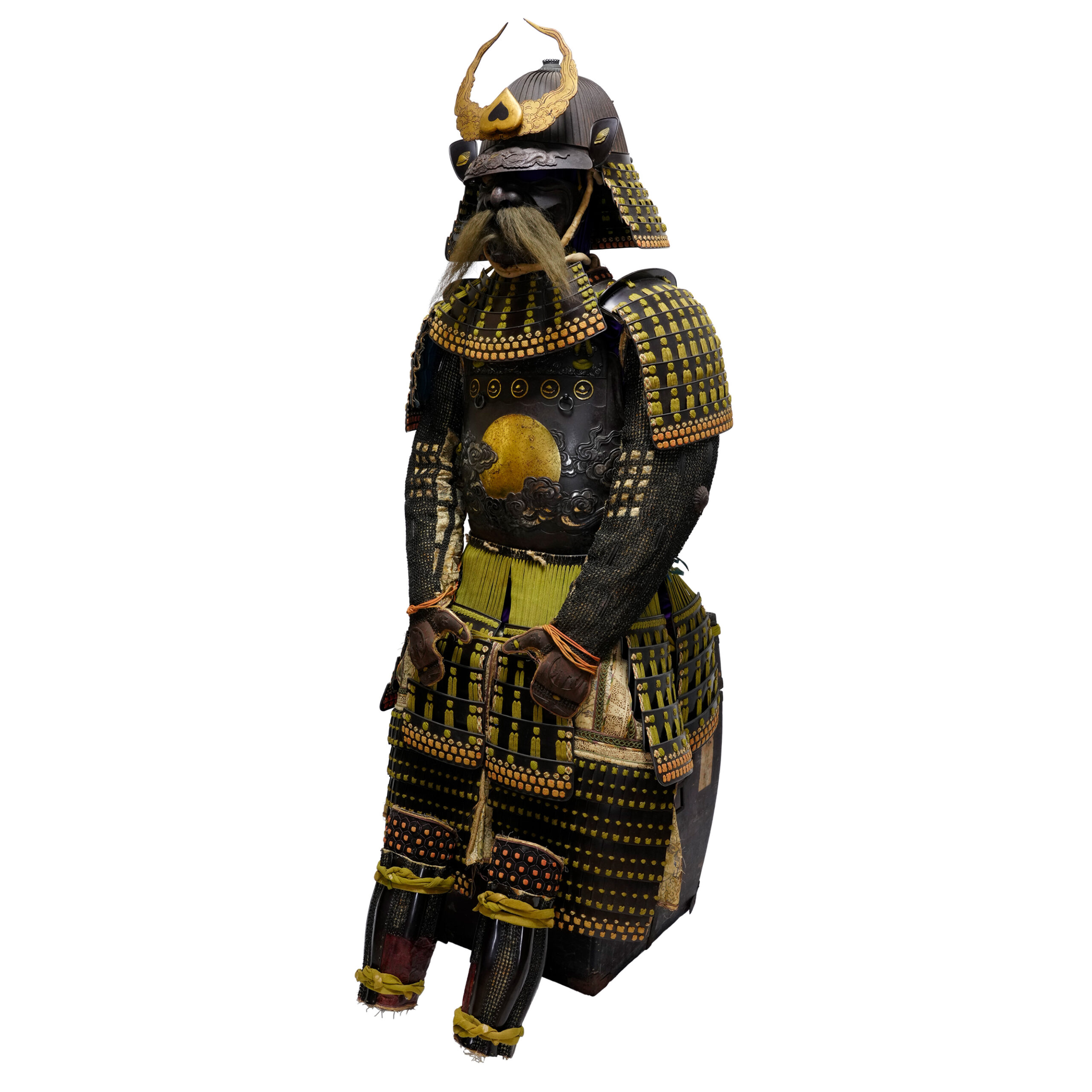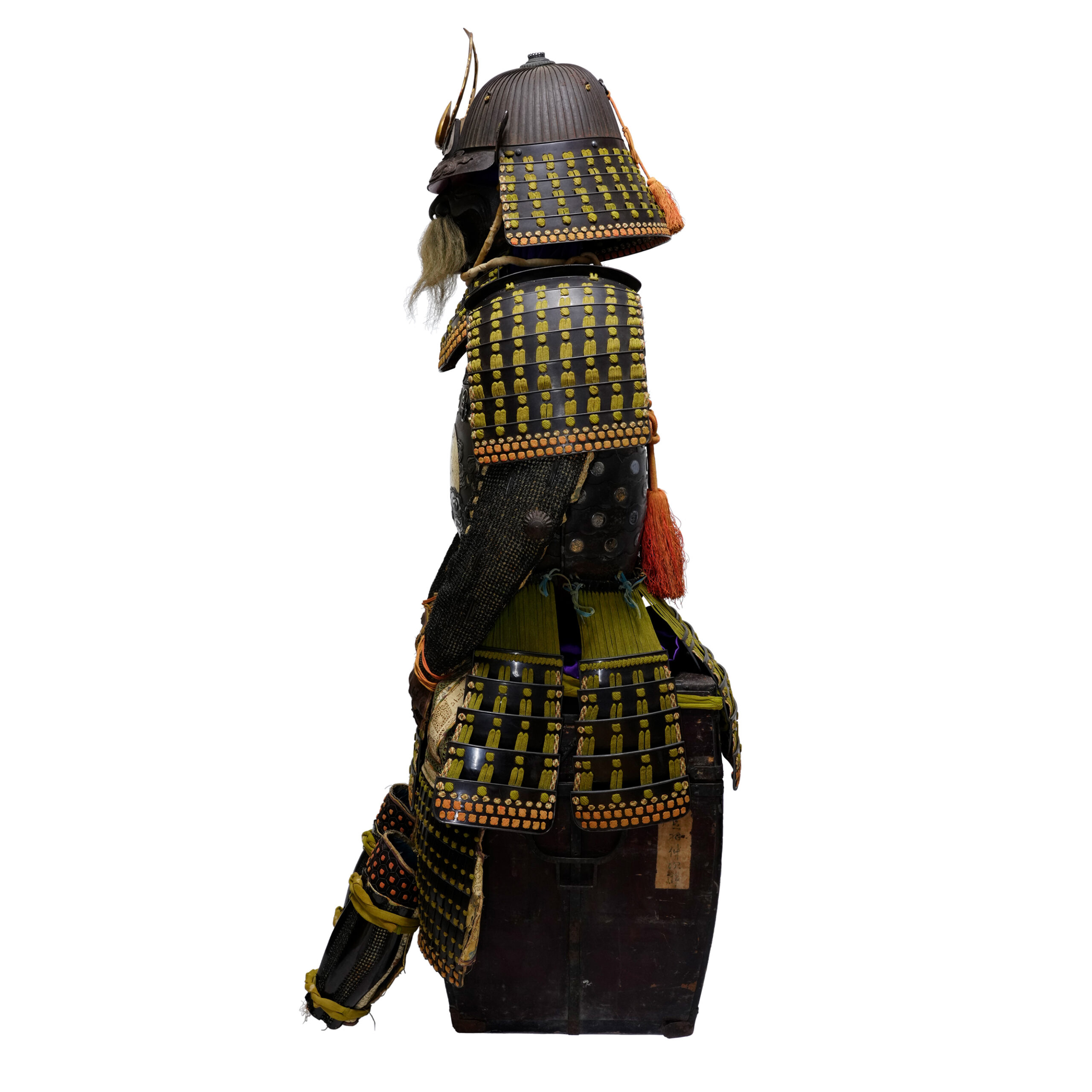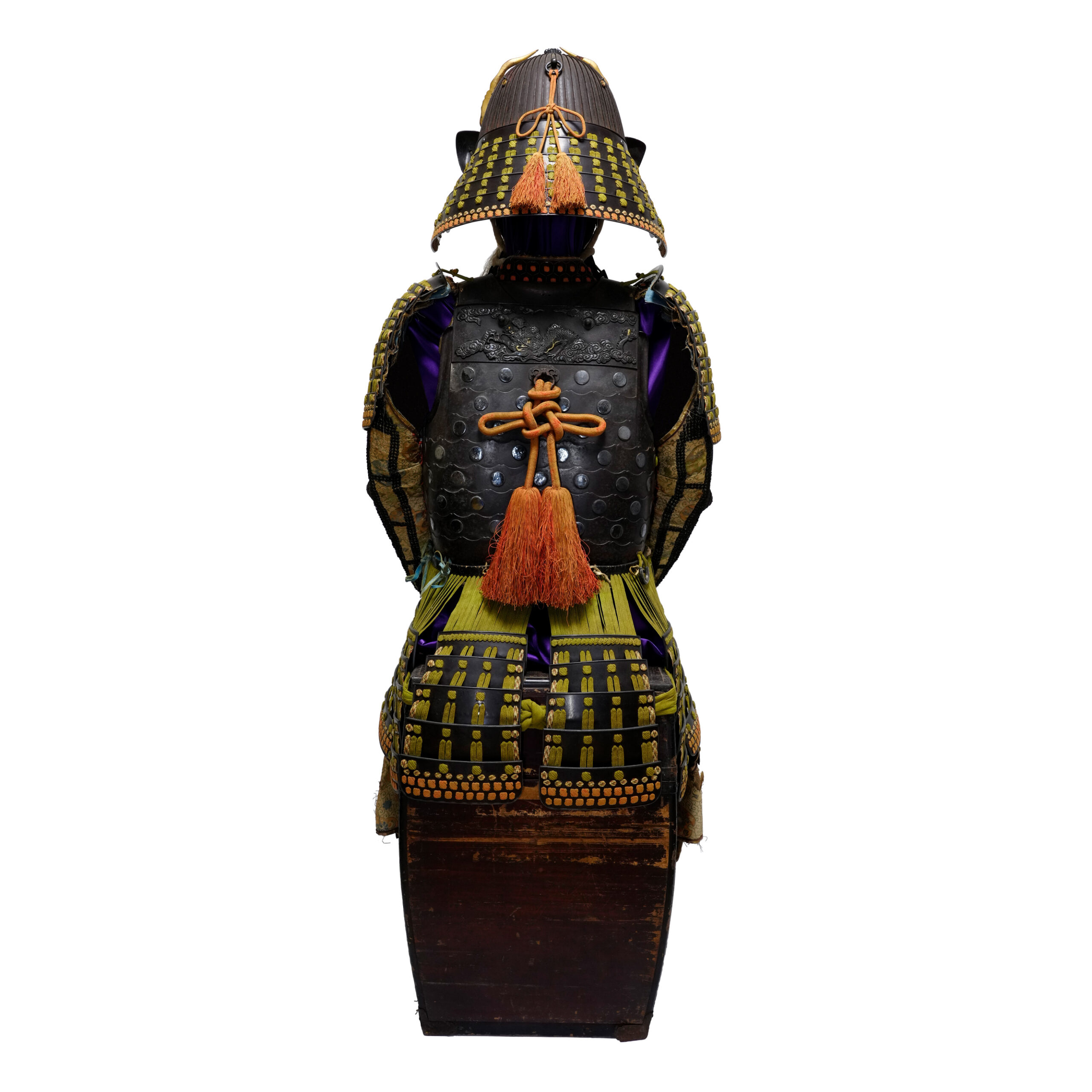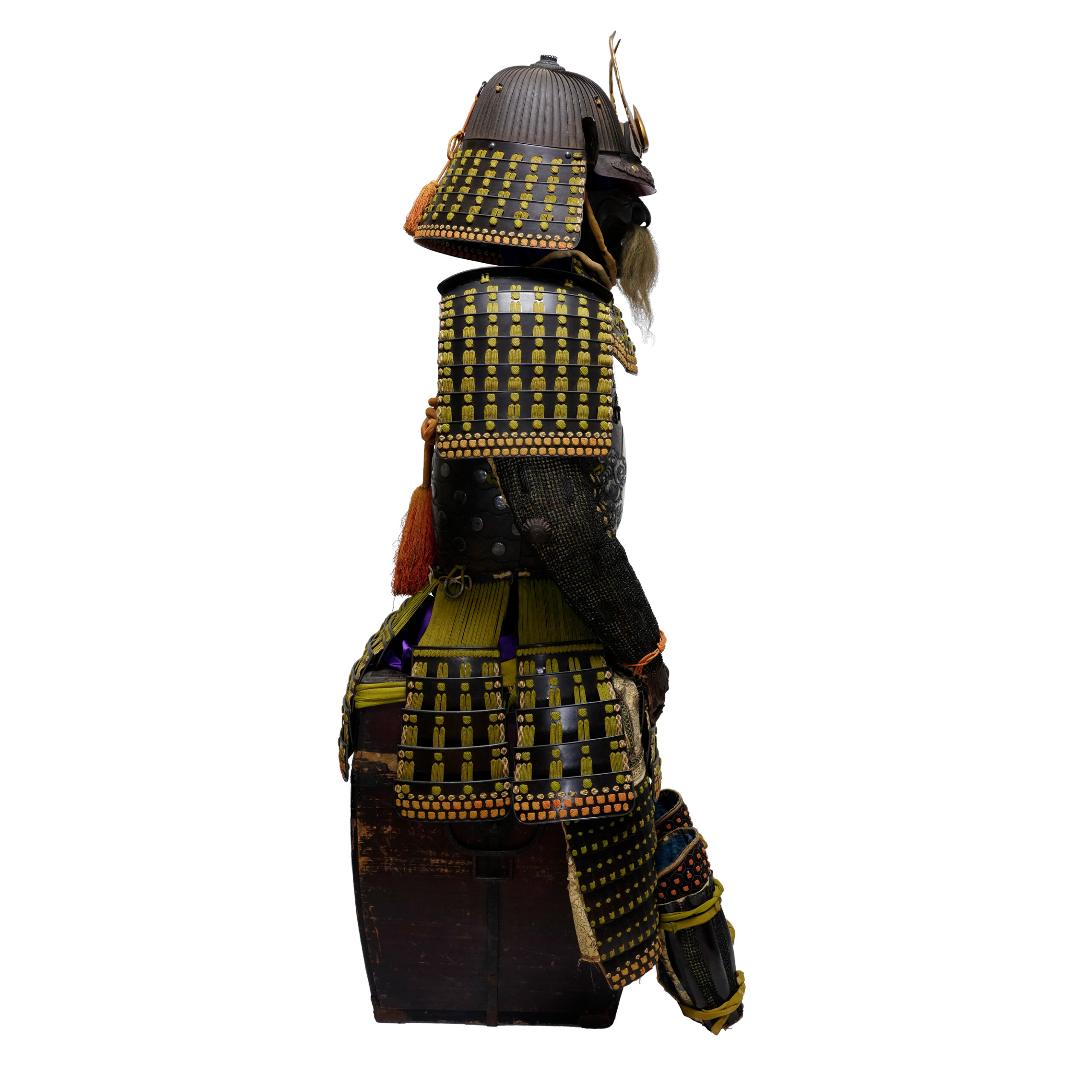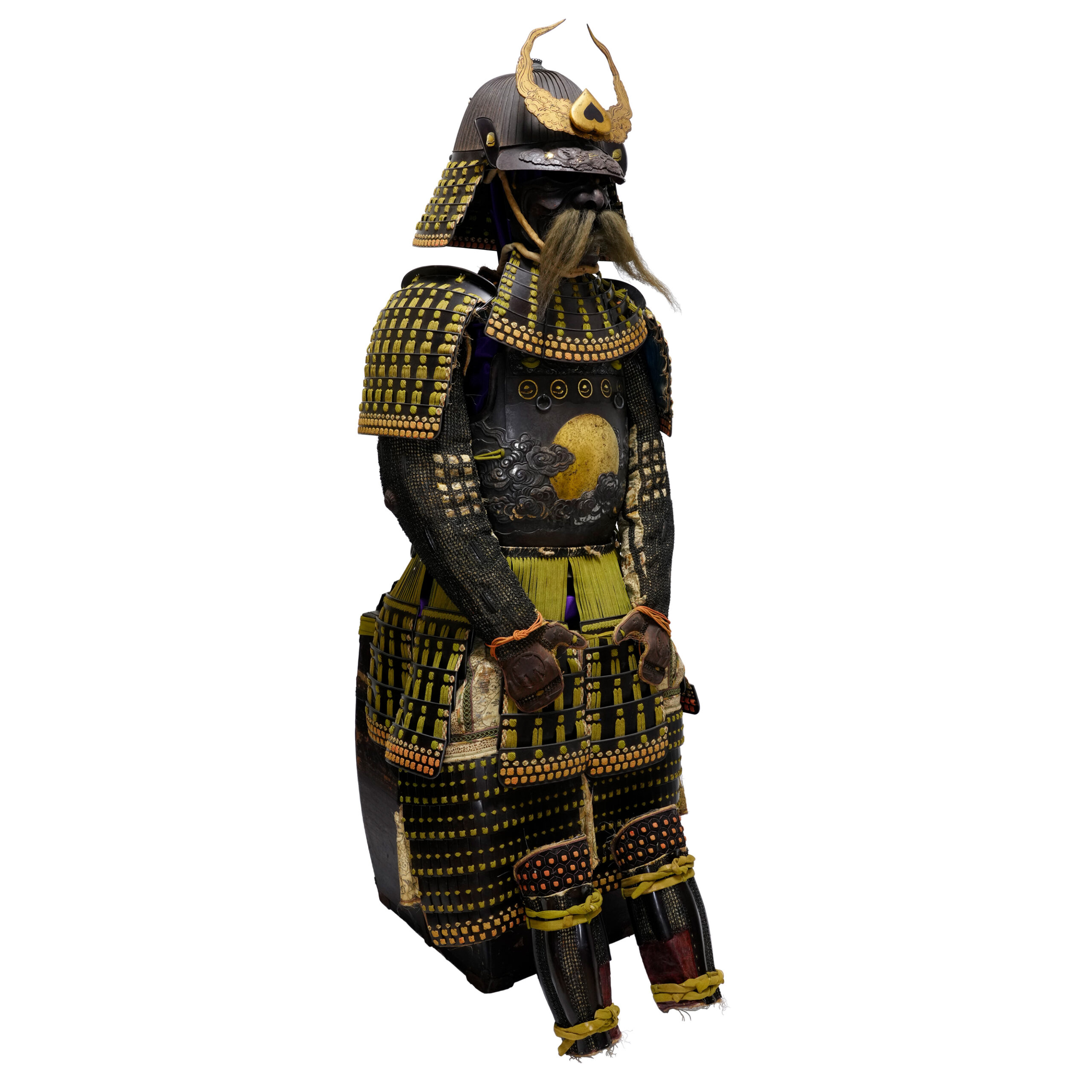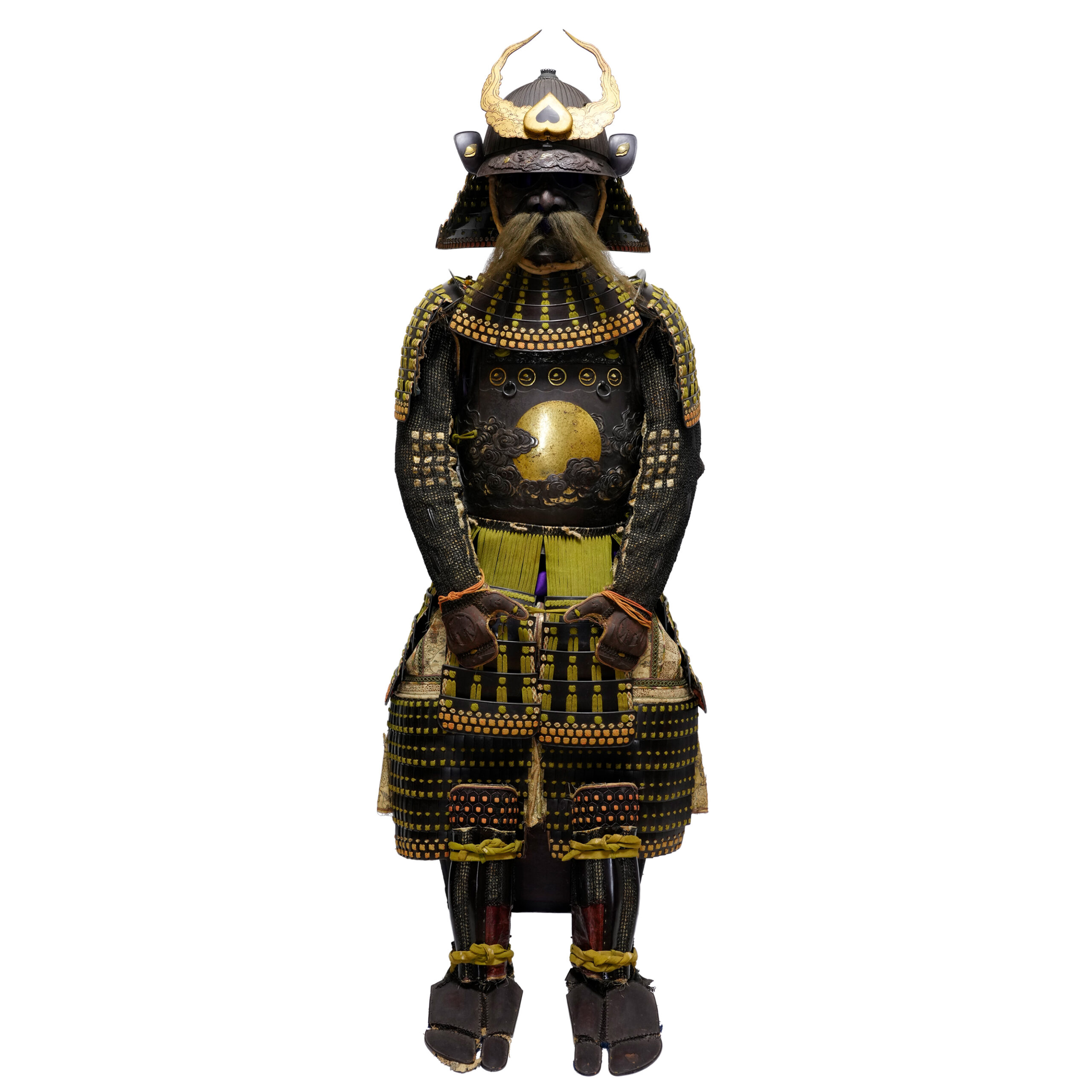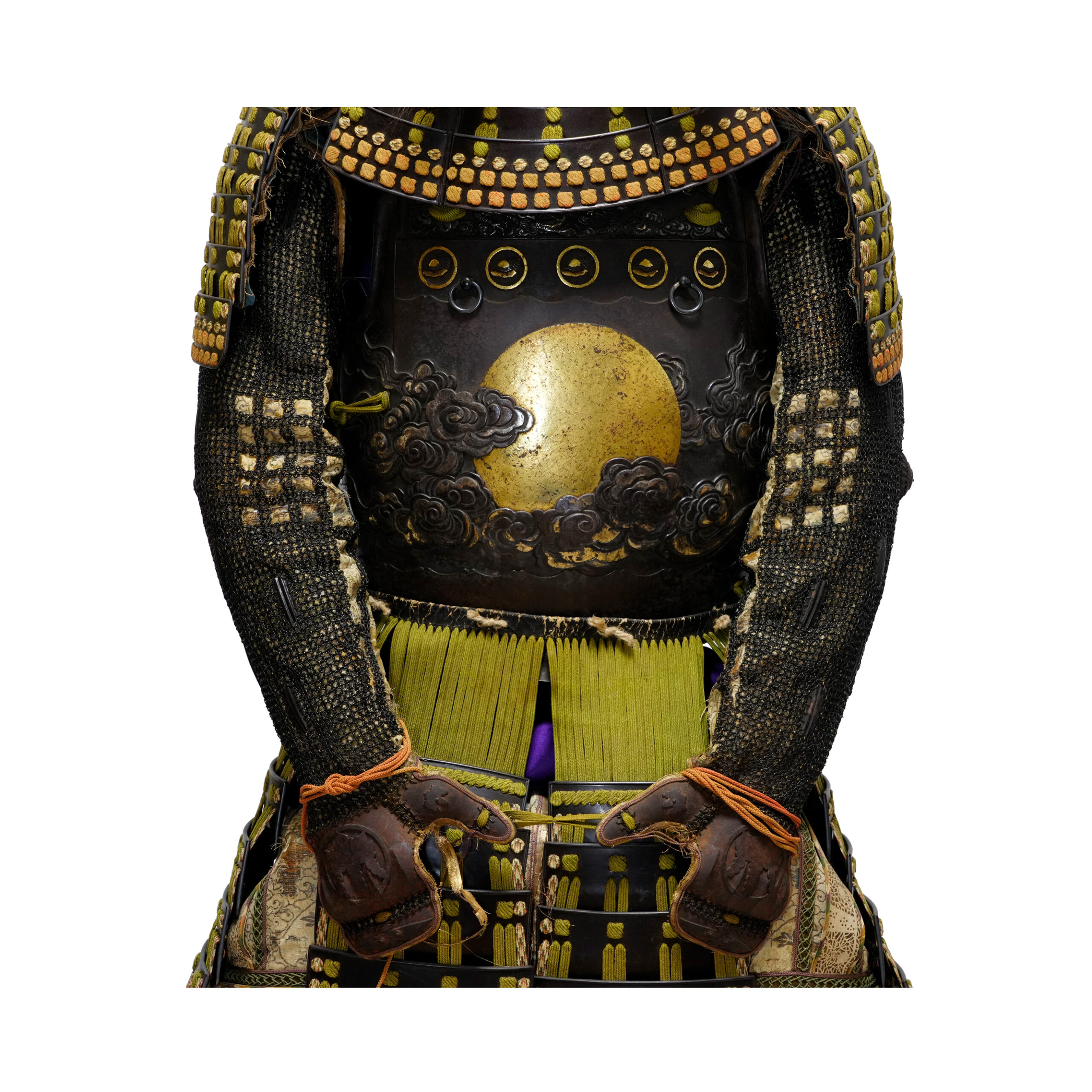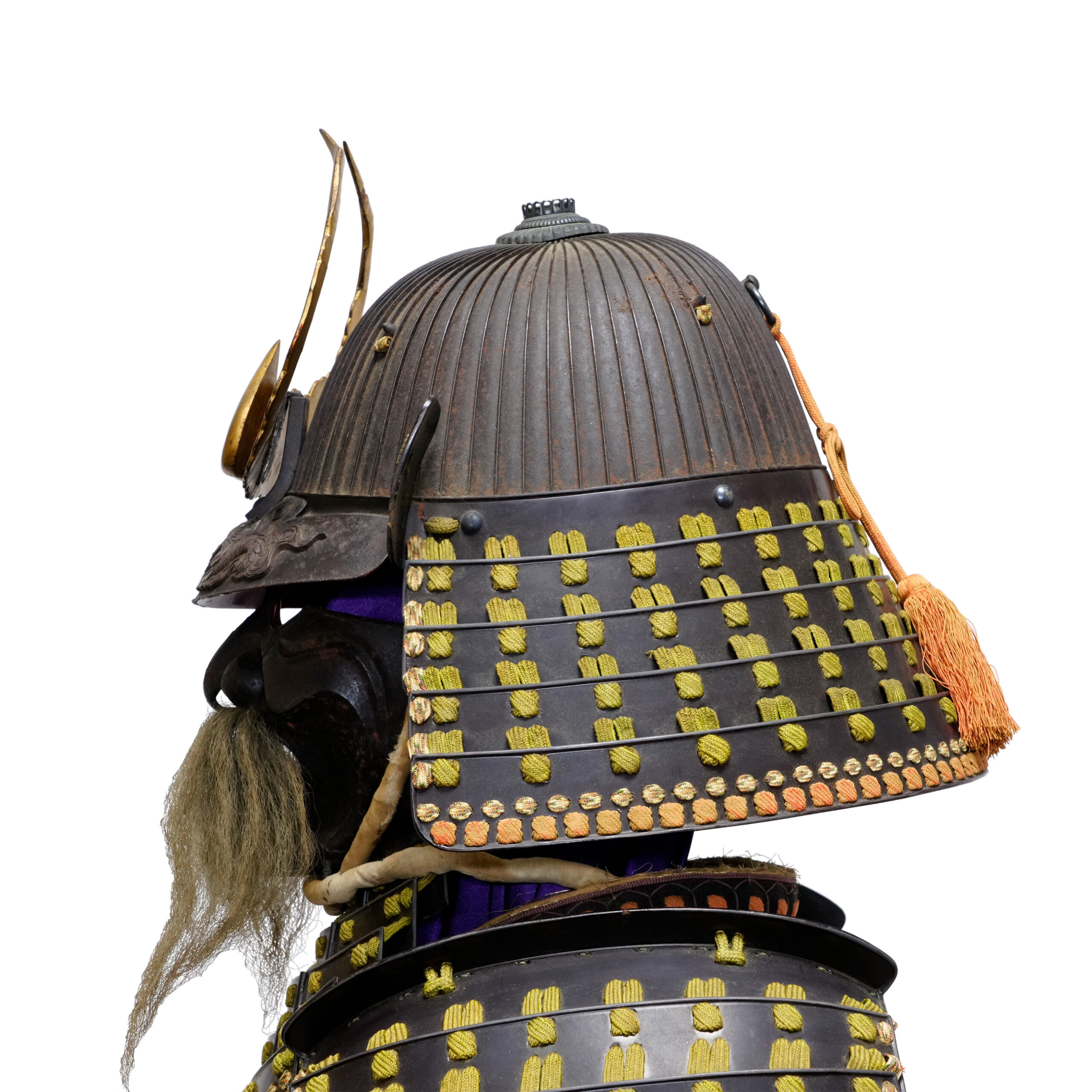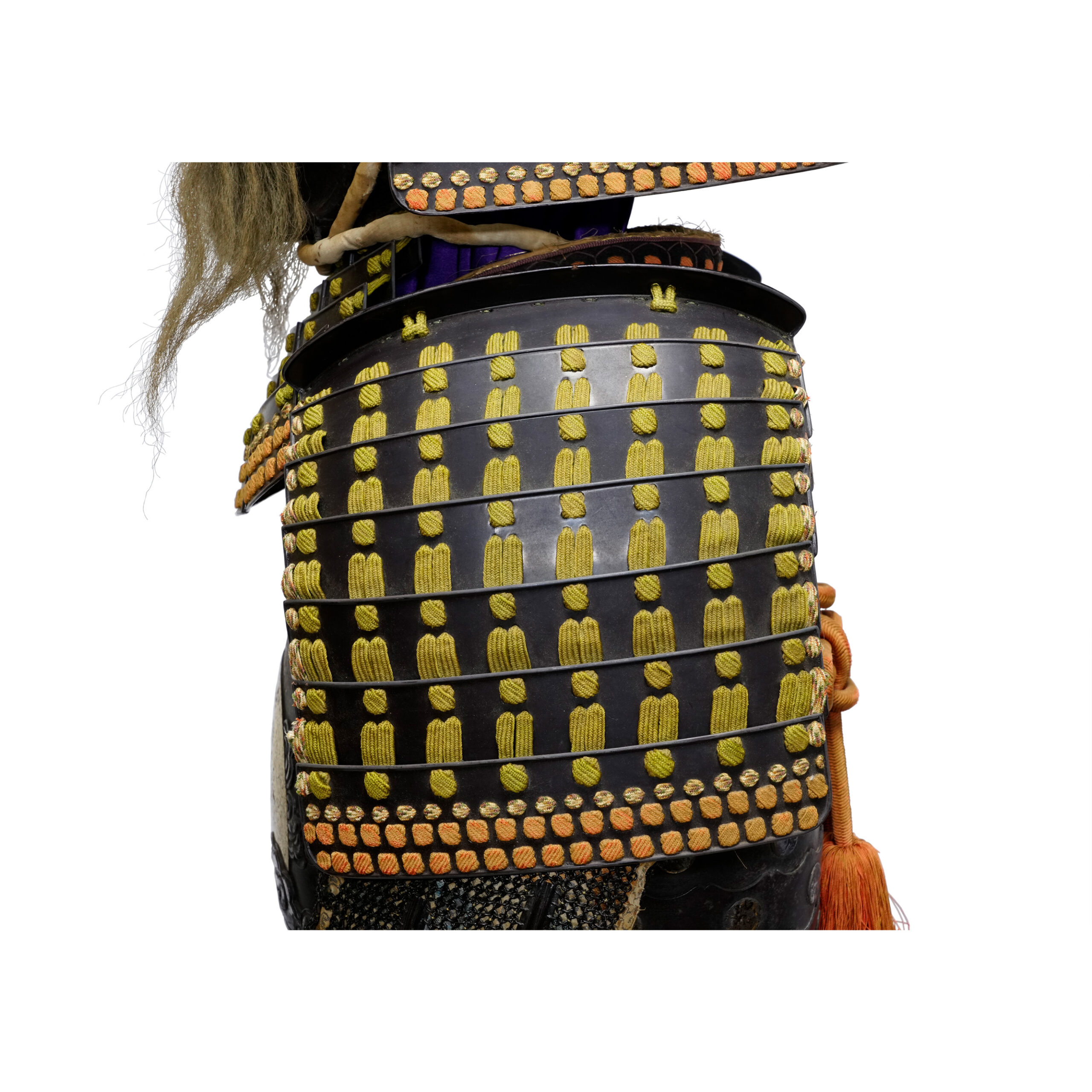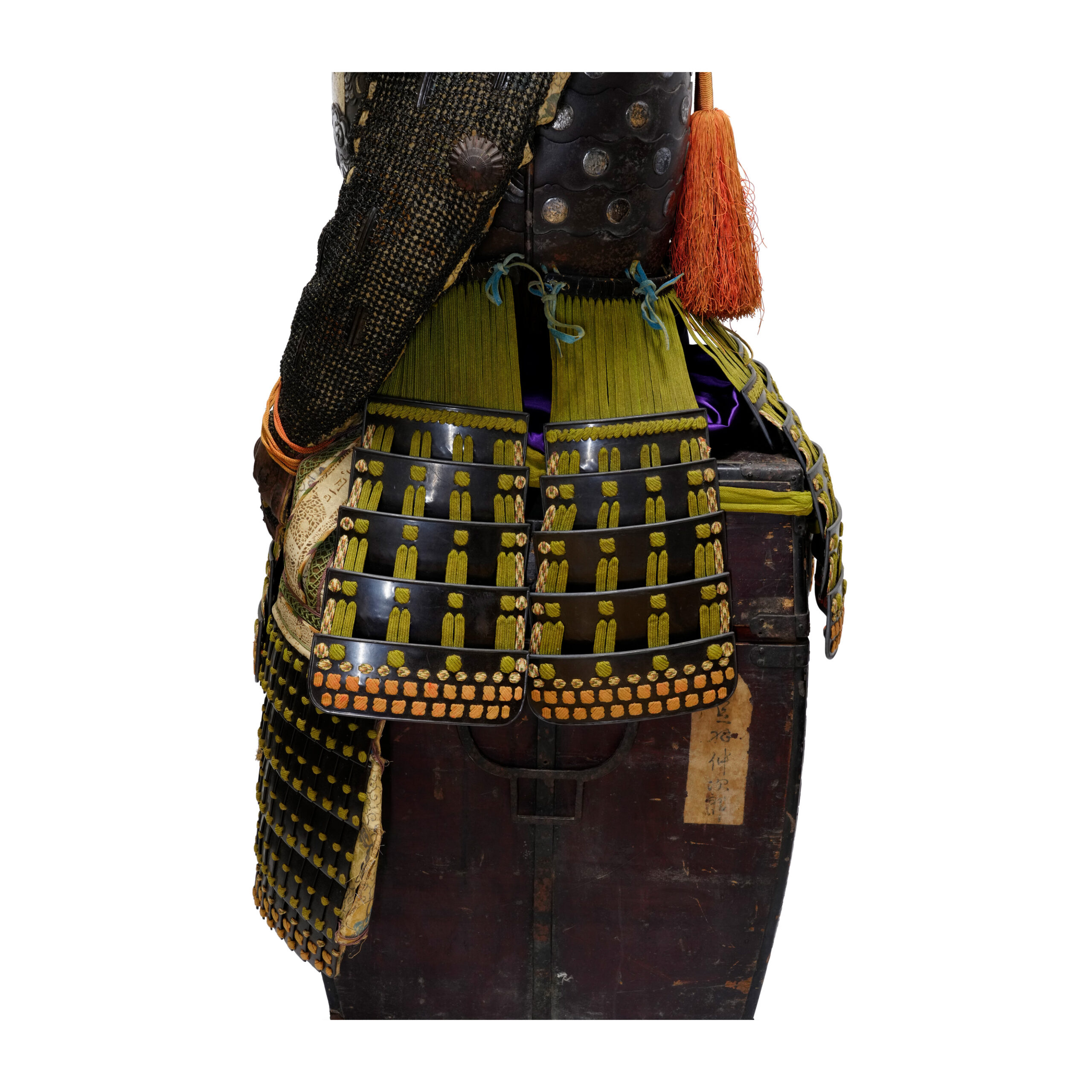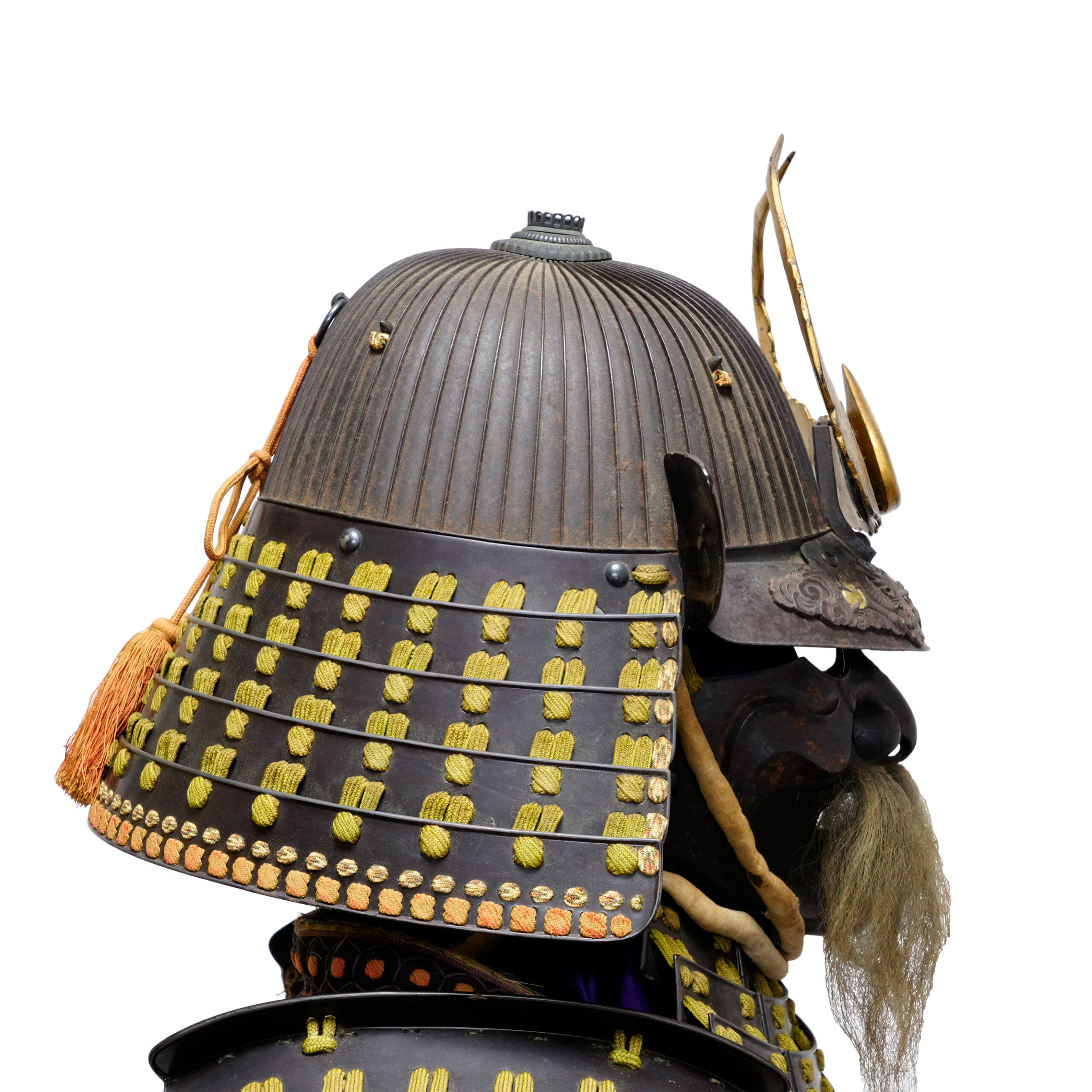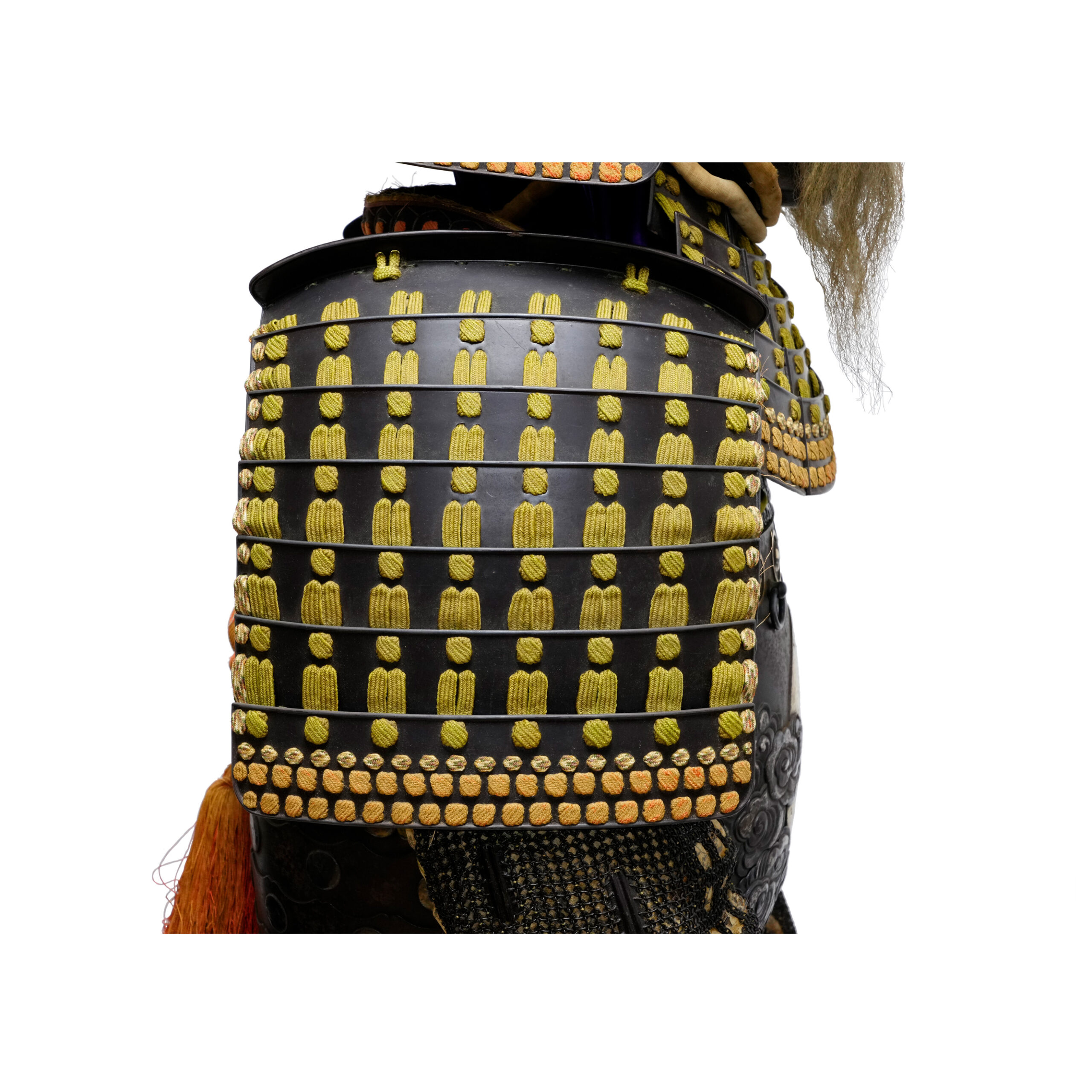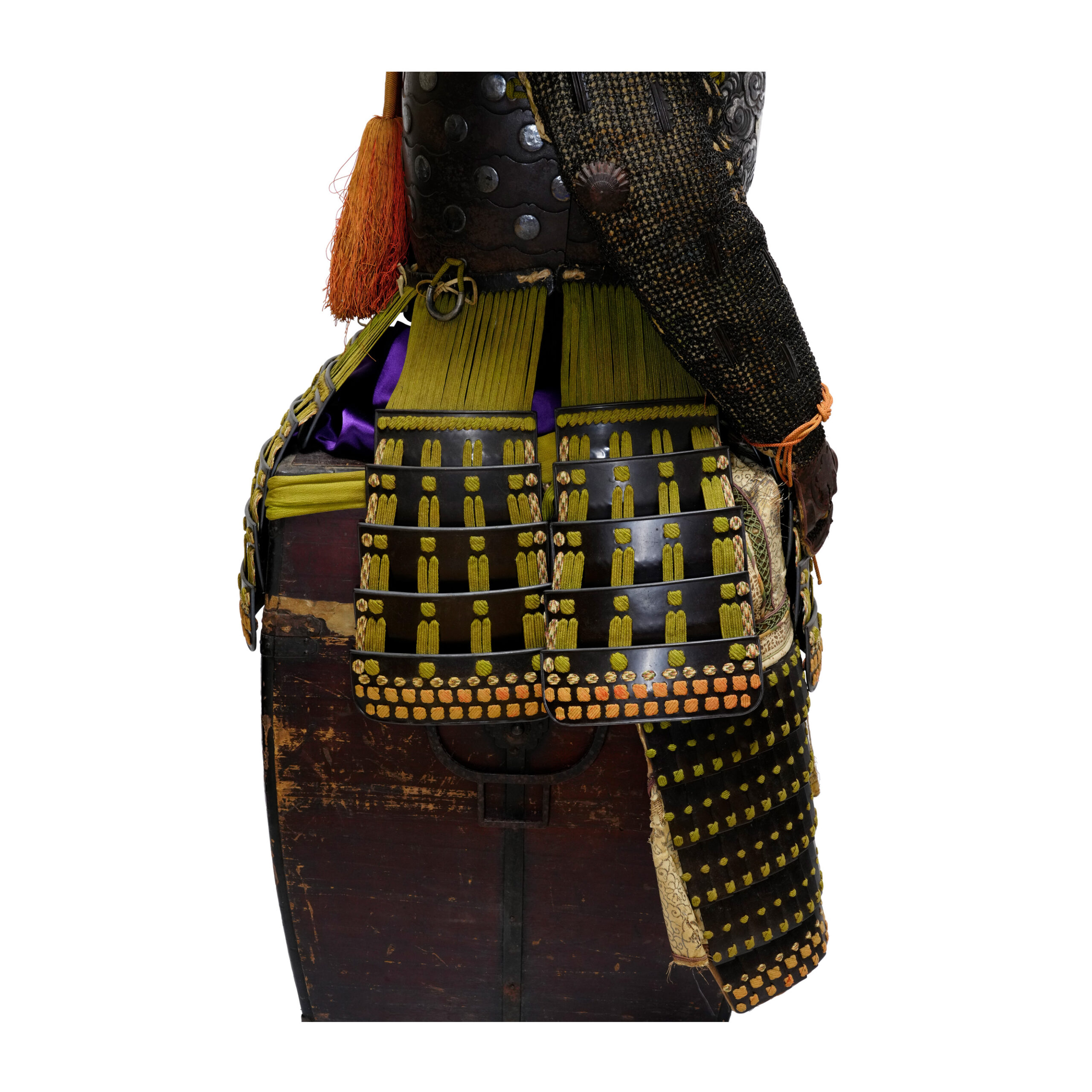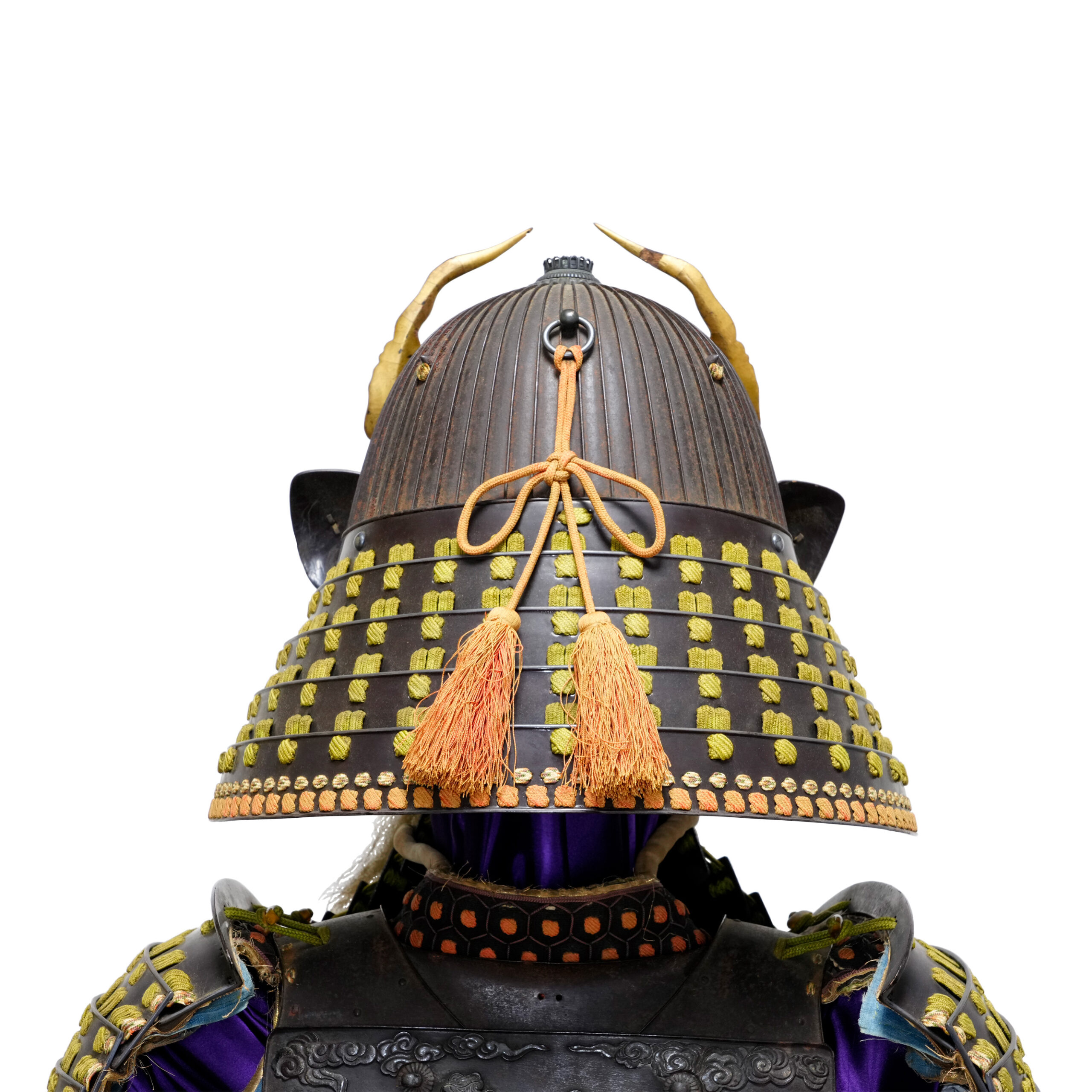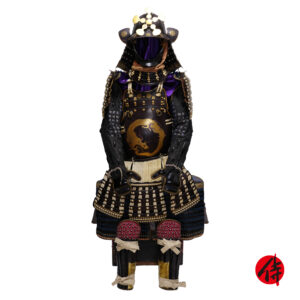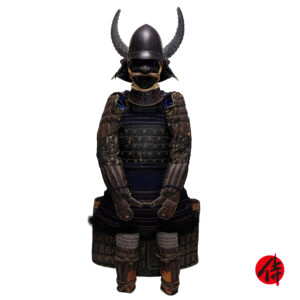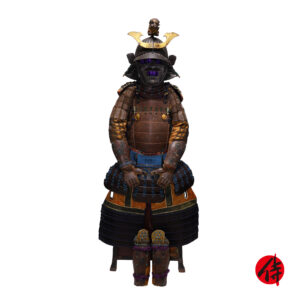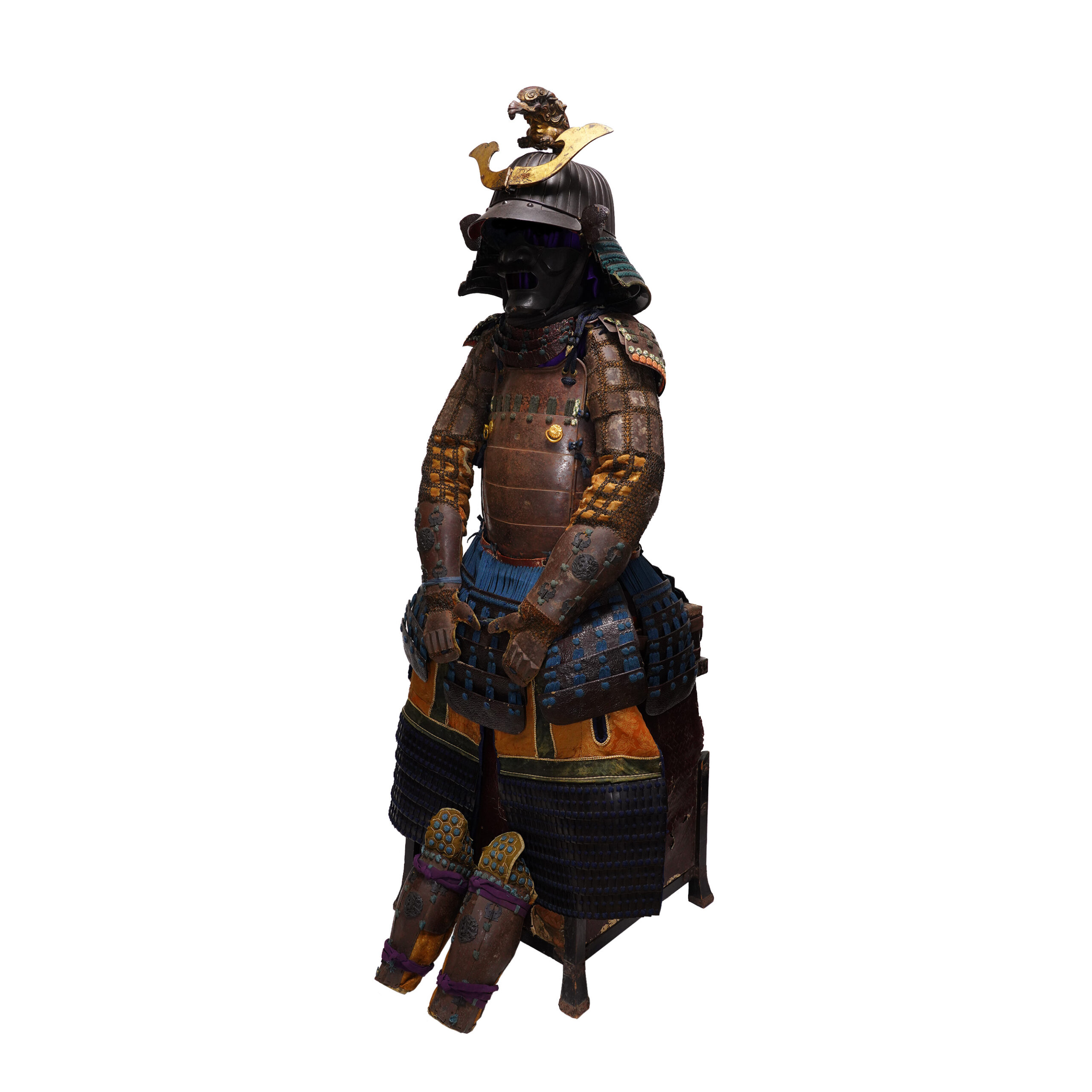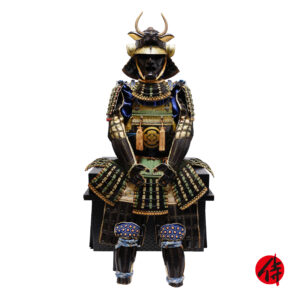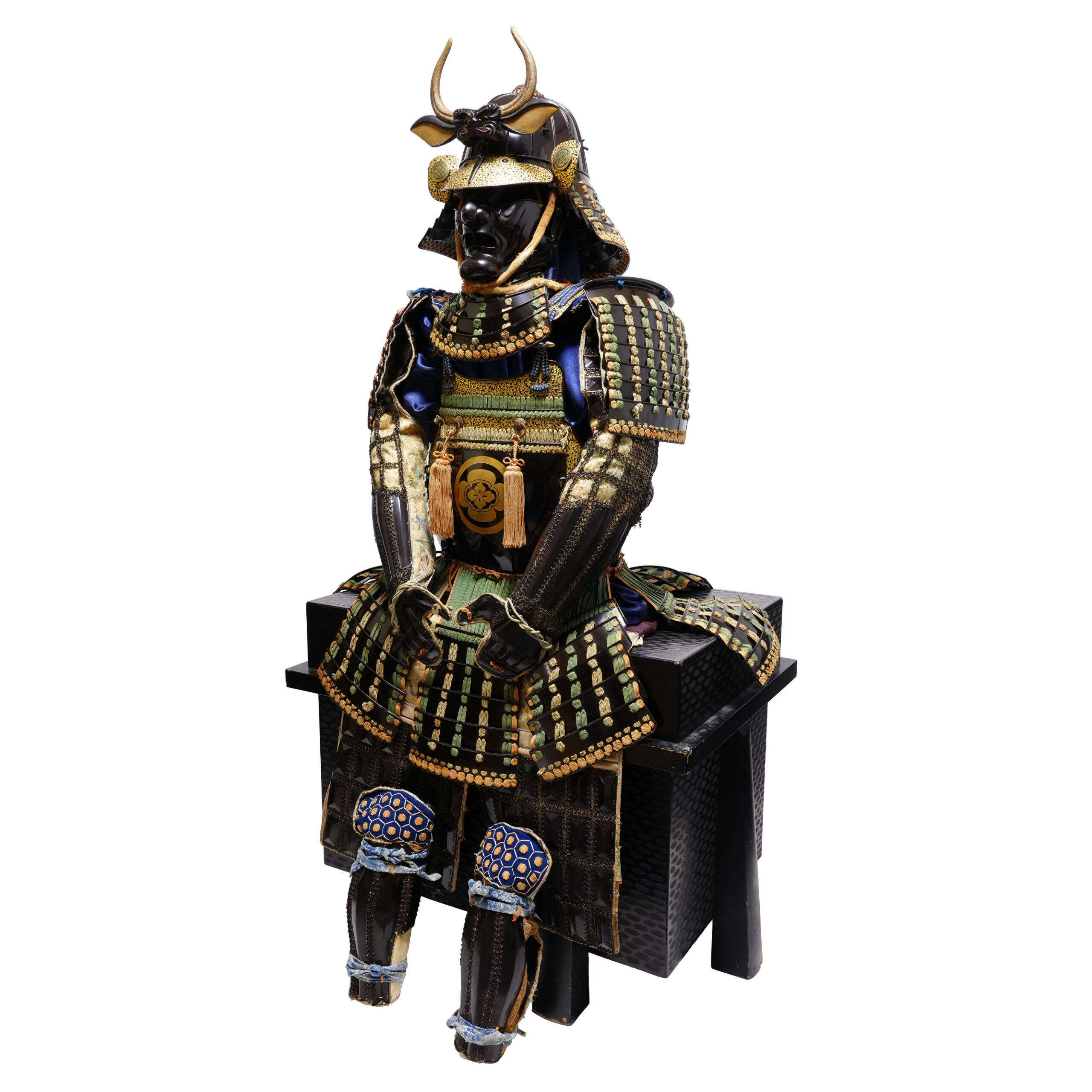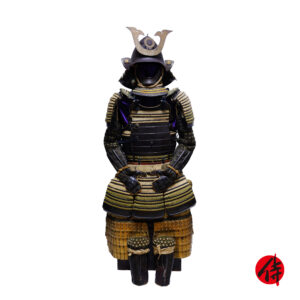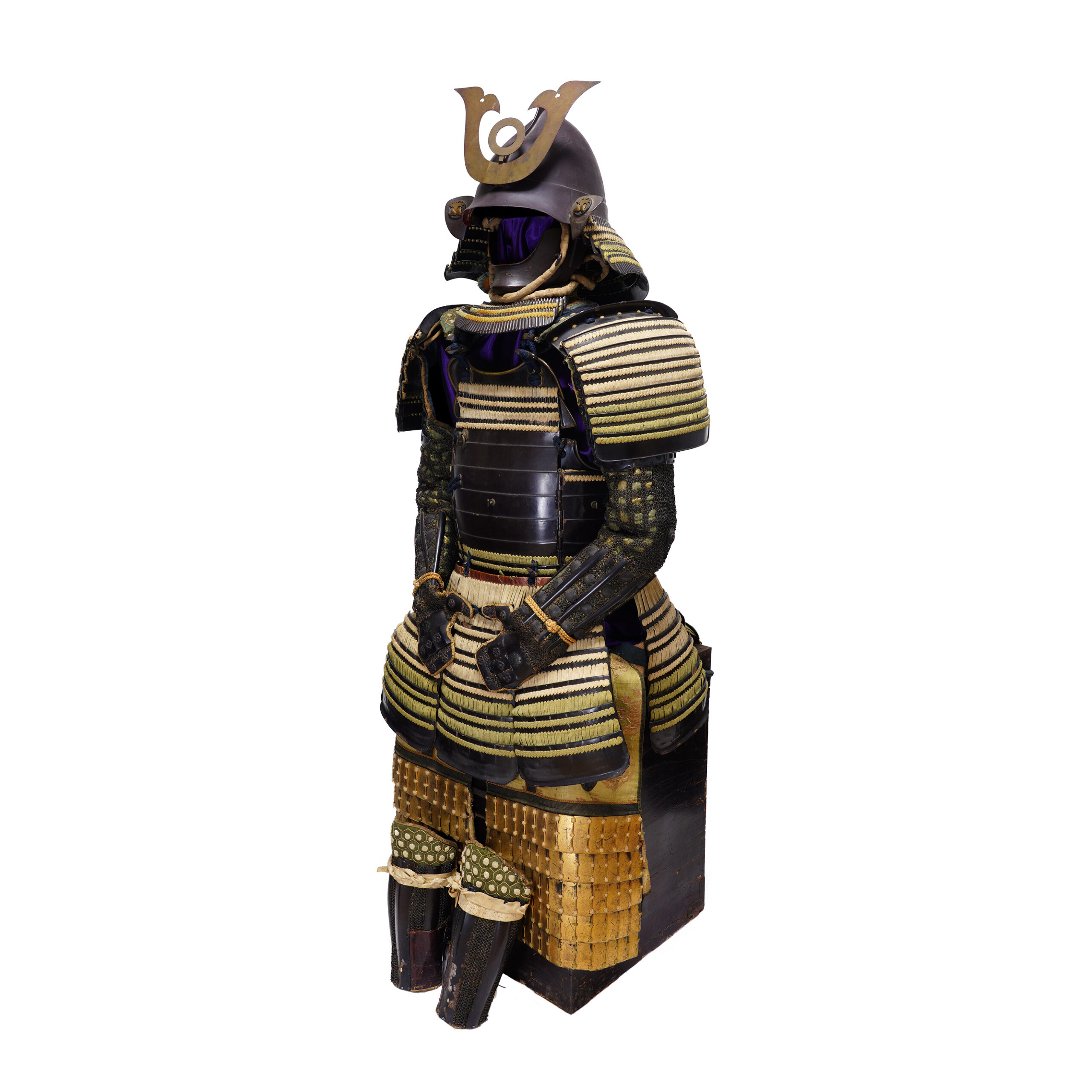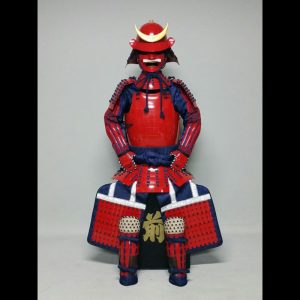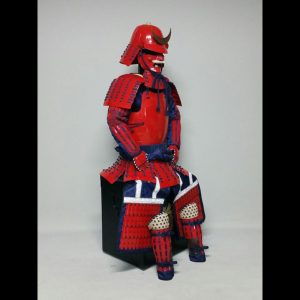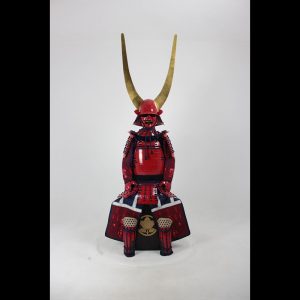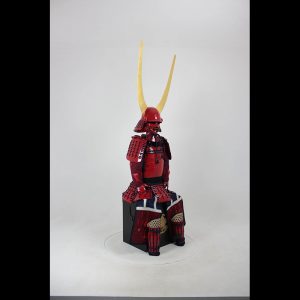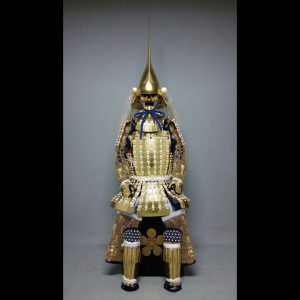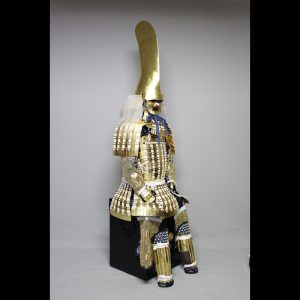Antique Mid Edo Period Samurai Armor Tokubetsu Kicho Shiryo Certificate (A-31)
Period: the middle of the Edo Period
appraised by The Association for the Research and Preservation of Japanese Helmets and Armor

Kabuto (helmet)
■Helmet bowl: Suji Kabuto
The Kabuto (兜, helmet) is a protector for the head. When people started using the Kabuto, it was initially designed for practical use. However, the principal purpose of its design has changed with time; Samurai warriors tried to express their dignity, personality, or religion by wearing the characteristic designed Kabutos. According to a theory, these uniquely designed Kabutos were made from the late Muromachi (室町後期, 1467-1573) to the Edo period (江戸, 1603-1868). This type of Kabuto is categorized as the Kawari Kabuto (変わり兜), and a variety of materials were used to create them. For example, animal fur, seashells, plants, and paper were used as materials for decoration.
Here we would like to introduce to you a little bit more about the history of Kabutos. Before the Kawari Kabuto’s production, the Suji Kabuto (筋兜) appeared during the Nanbokuchou (南北朝, 1337-1392) period. At that time, the tactic was gradually changed from the piggyback fight style to battle with the Tachi (太刀) sword and the Naginata (薙刀, Japanese halberd) on the ground. Therefore, there was a rise in demand for the weight-saving of the Kabuto. Also, in order to turn the attack by swords, a new type of structure was invented: the Suji Kabuto (筋兜). Its form slides swords’ attacks when weapons hit the Kabuto. It is said that the production of the Suji Kabuto prospered in the Muromachi (室町, 1336-1573) period. We estimate this Kabuto is one of these Suji Kabutos made in that tendency in the Edo period. It has 62 stripes in this Kabuto, meaning 62 small iron plates are connected. It is called Rokuju Ni Ken Suji Kabuto (六十二間筋兜). Rokuju Ni means 62 in Japanese.
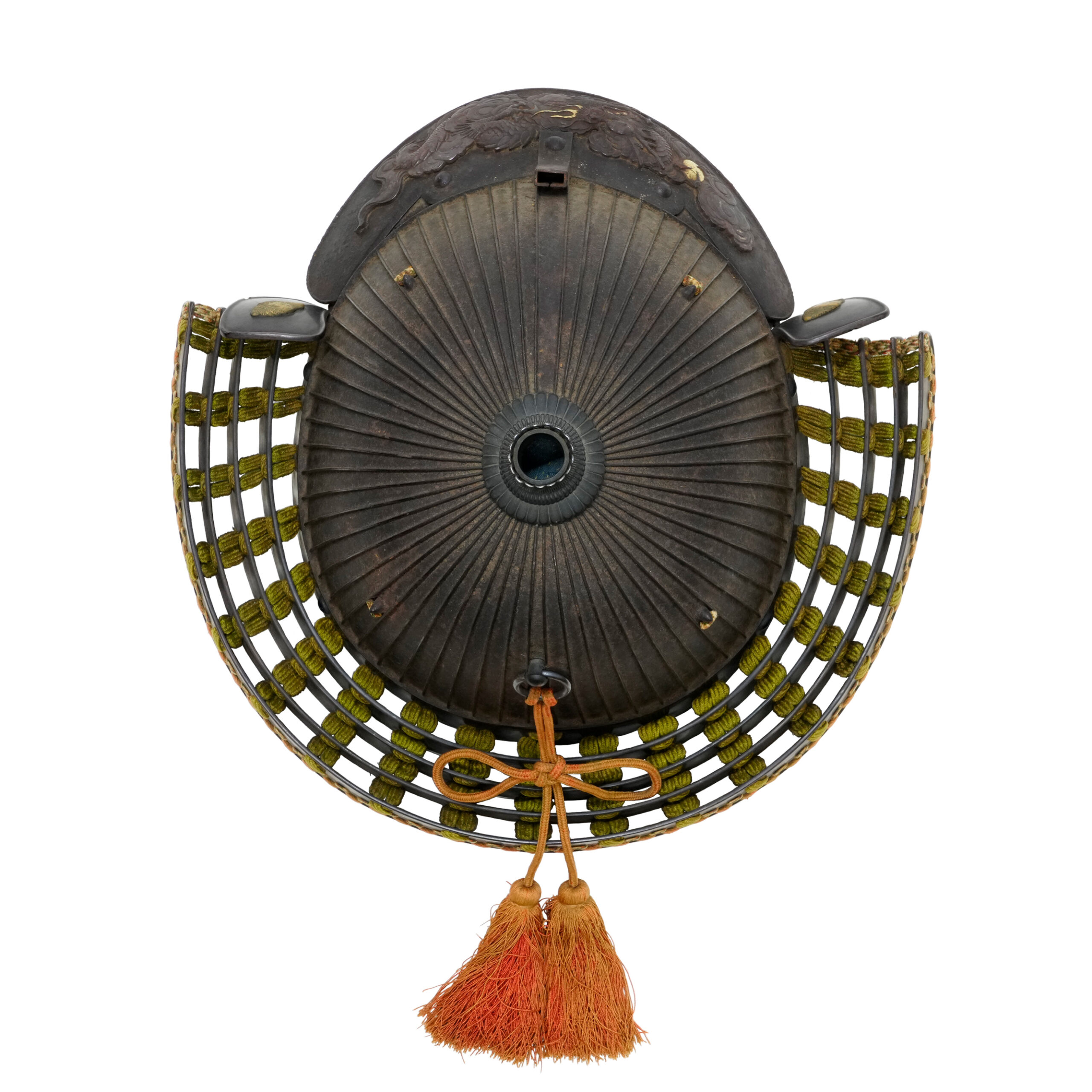

■Shikoro (side neck guard):
Iron plates laced with green, vermillion, and white threads.
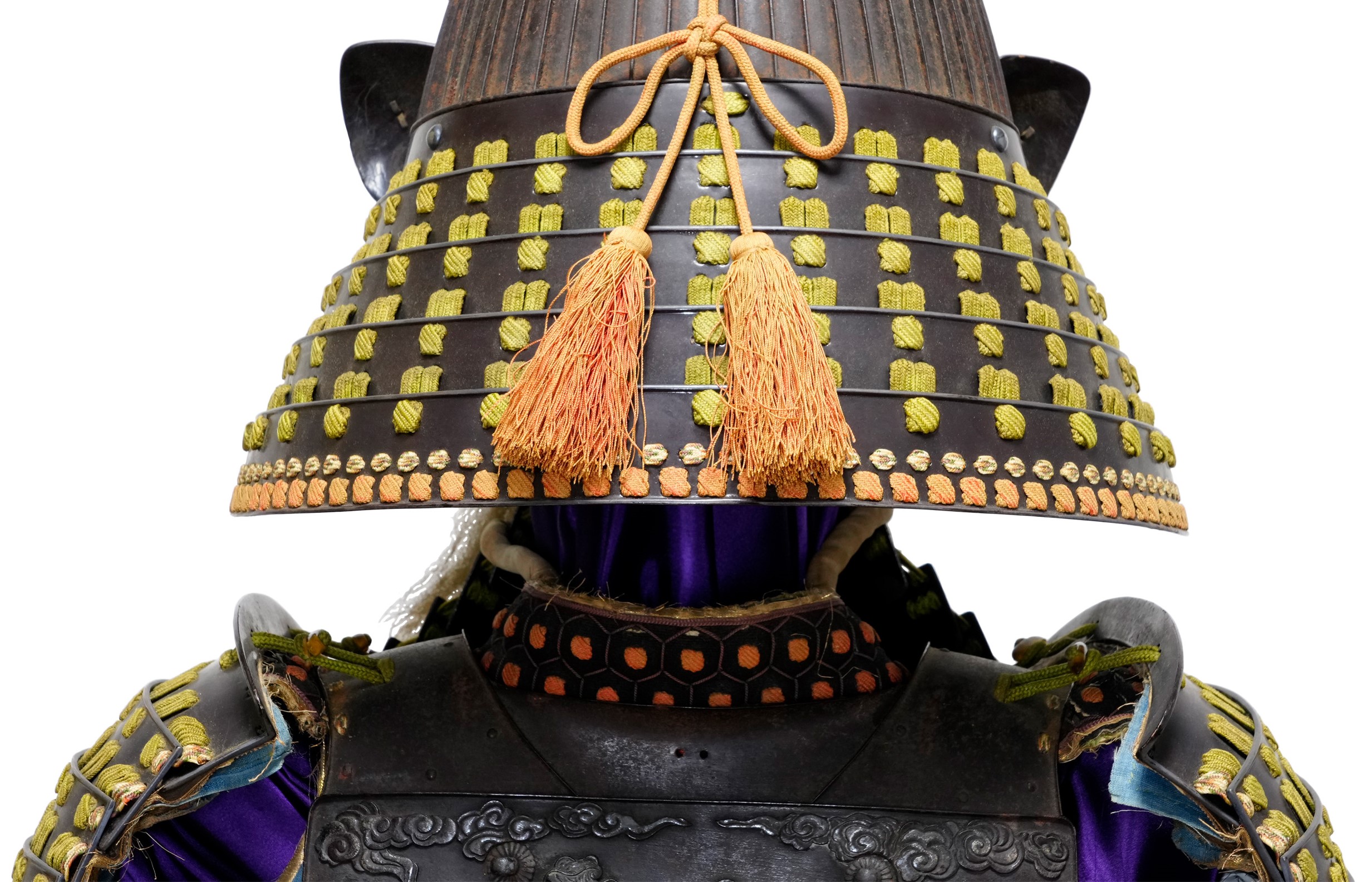
■Fukikaeshi (side neck guard): Kai Mon
The Fukikaeshi (吹き返し) is both ends of a Kabuto. It protects the face from swords and also shows its beautiful workmanship. Family crests are sometimes designed on this part, as seen on this Kabuto. The Fukikaeshi of this Kabuto is decorated with a golden seashell pattern. This design is called the Kai Mon (貝紋, 貝 means shell in Japanese), and the seashell designed on this Fukikaeshi is probably the Horagai (法螺貝, trumpet shell).
Shellfish have been eaten all over the world since ancient times. At the same time, they have been used in a wide variety of applications, such as coins, ornaments, daily necessities, and toys, due to the beauty and preservability of their shells. In Japan, there is also a folk belief that seashells with prominent projections are hung from the eaves to ward off evil spirits, and their names are said to ward off fire, such as the Suijigai (水字貝, 水 means water in Japanese). In addition, ascetic monks who trained in the mountains blew trumpet shells to exorcise evil spirits. During the Warring States period (戦国時代, 1467-1615), trumpet shells were used to signal the formation of battle lines and to boost the fighting spirit. It is only natural that this shell, which was used as a cue in battle and to raise the fighting spirit of soldiers, was incorporated into the decoration of armor, which is the uniform of fighting.
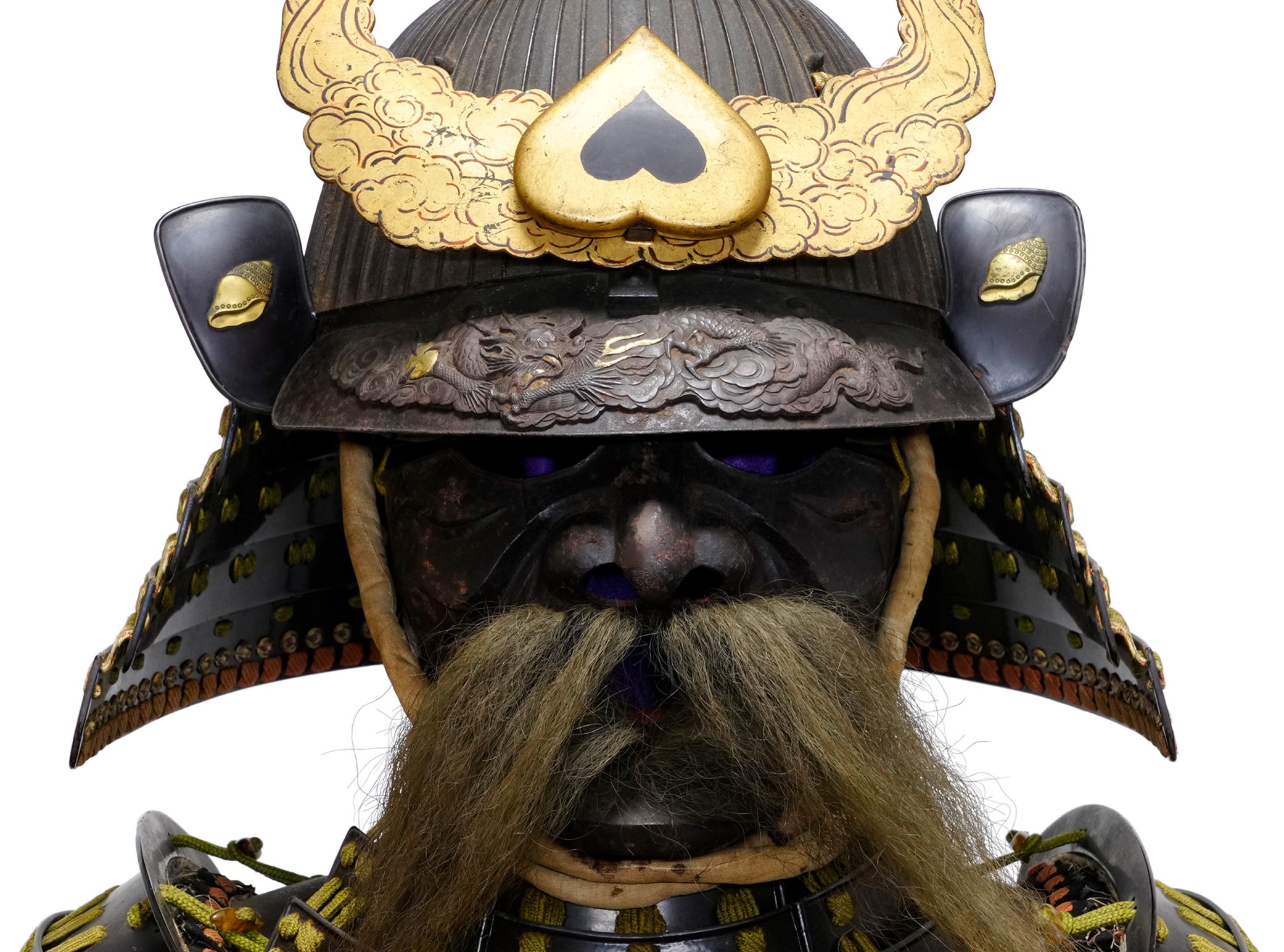
■Menpo (face guard): Ressei Menpo
This type of Menpo is called the Ressei Menpo (烈勢面頬). It represents the angry face to intimidate enemies. There are many types of Menpo, depending on their shape or appearance. The purpose of Menpo was not only to protect Samurai’s face. But also to hide their true faces so that their psychological states were unaffected. Long beards are attached to this Menpo. Thanks to this effect, even a young soldier would have been able to produce the majestic appearance of a middle-aged Samurai.
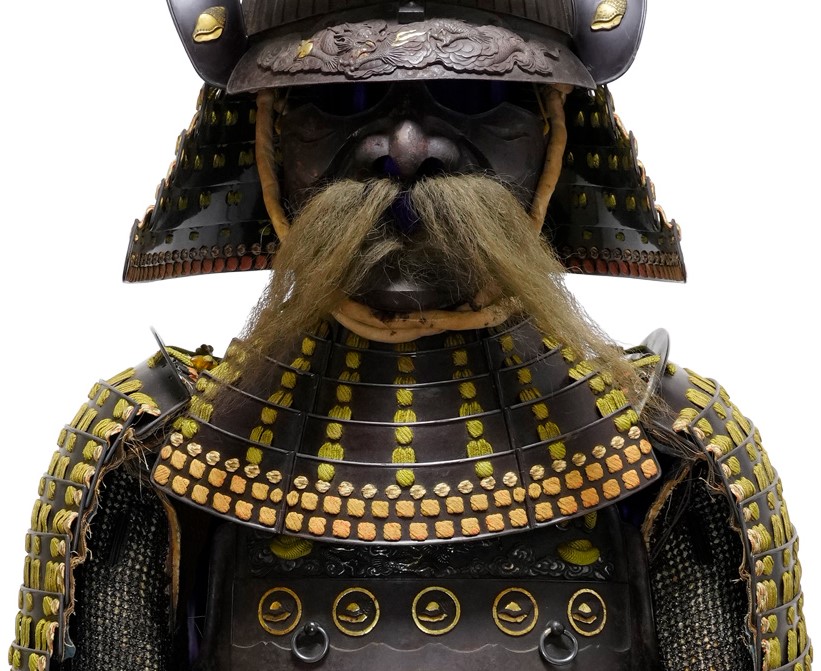
■ Maedate (front decoration): Inome Mon
You would find a decorative part whose shape is an upside-down heart mark. It is attached to a two-pronged, horn-like ornament with a cloud pattern. We believe the motif of this Maedatemono (前立物, front decoration) is the Inome Mon (猪の目紋). The Inome pattern has been used since ancient times. Its name implies boar’s eyes. Some people believed the Inome design would work as an amulet to protect them from evil spirits or fire. Also, it is said it would bring good luck.

Armor
■Dō (cuirass): Nimai Dō
Nimai Dō is a kind of cuirass for Tousei Gusoku (当世具足, developed armor style). Nimai Dō (二枚胴) was named after the fact that Nimai (二枚) means two plates and Dō (胴) means torso in Japanese. Instead of using a large number of small lamellar plates called Kozane (小札), this cuirass used large iron plates riveted.
The same as the Mabisashi (眉庇/目庇, eaves of the bowl on the front of the helmet), the dragon is engraved on this Dō. The front of the Dō depicts a moonlit night with a large full moon shining golden and clouds, and the upper backside shows a dragon flying the sky through the clouds. Initially, the dragon is an imaginary creature found in ancient foreign traditions or myths. Furthermore, it is regarded as a symbolic beast of auspicious signs. Its body is likened to nine animals: antlers are deer, the head is a camel, eyes are demons, the neck is a snake, the belly is the Mizuchi (蛟, a mythical animal in Japan that looks like a snake and has a horn and four legs), scales are fish, claws are falcons, palms are tigers and ears are cows. It was thought that the dragon would reign at the top of all animals because of its odd-looking appearance.
The previously mentioned shell patterns are also seen here; there are many similarities with the design of the Kabuto. This Dō is highly decorative, and we assume this armor might have been made as a symbol of authority rather than for actual combat.
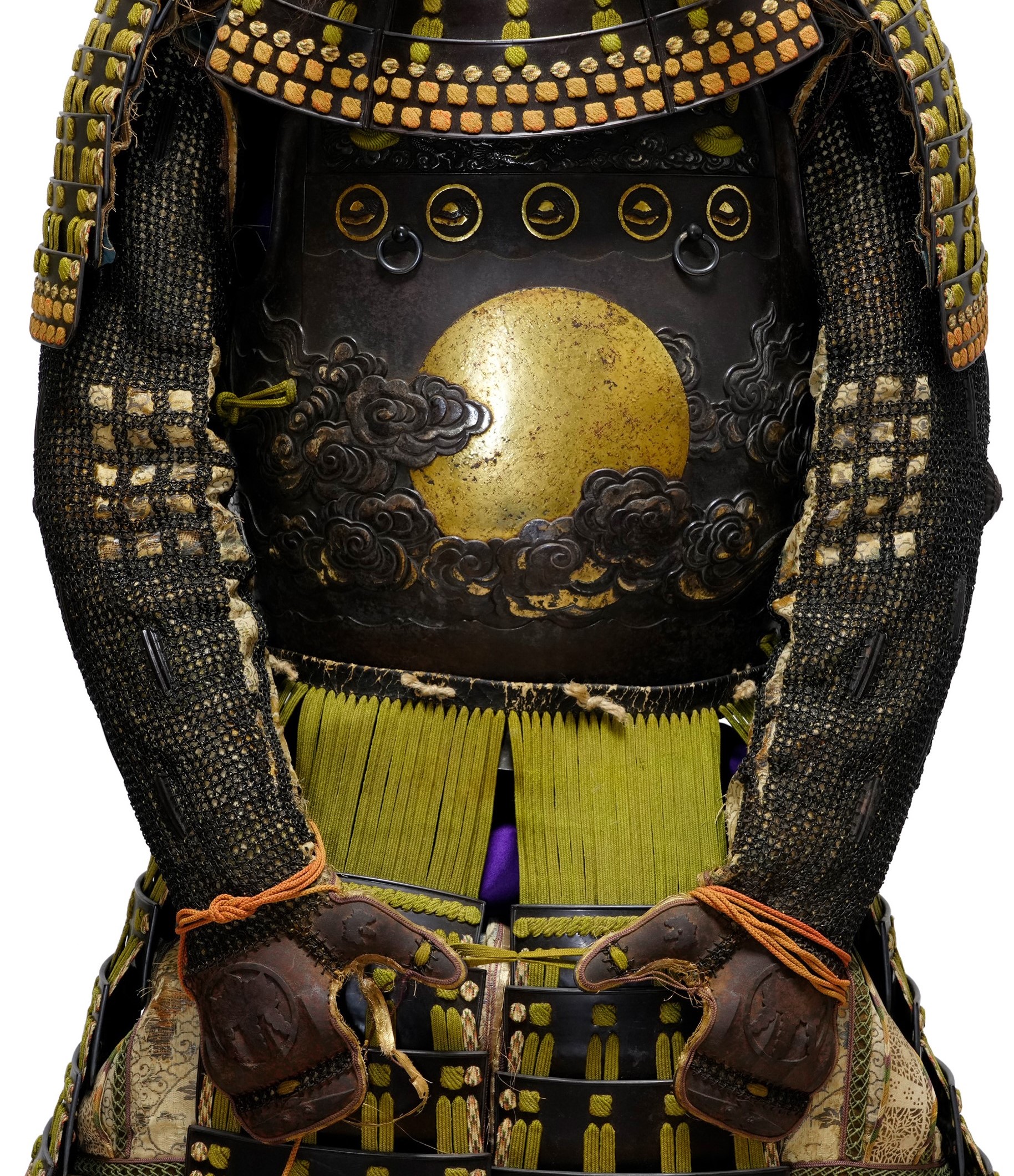

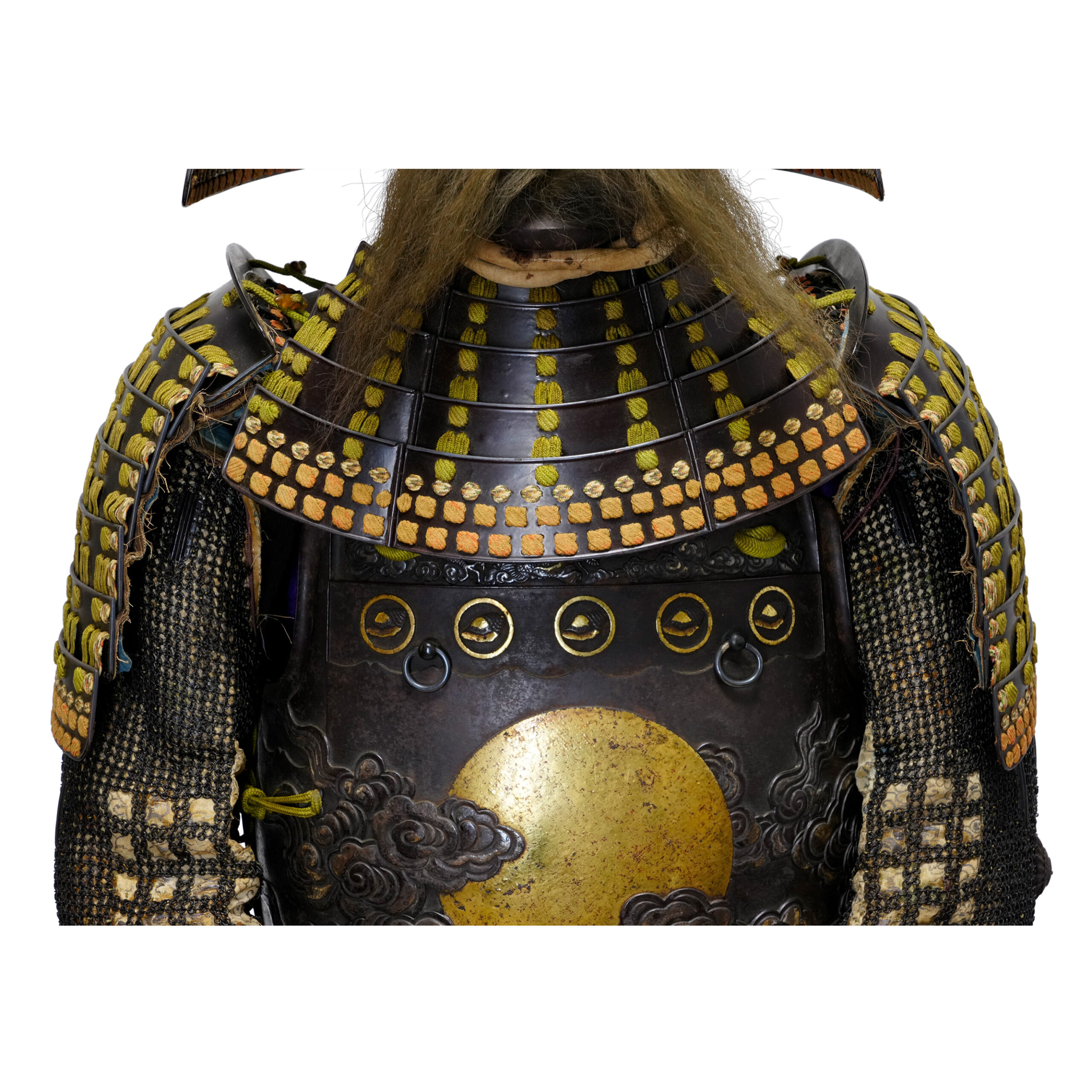
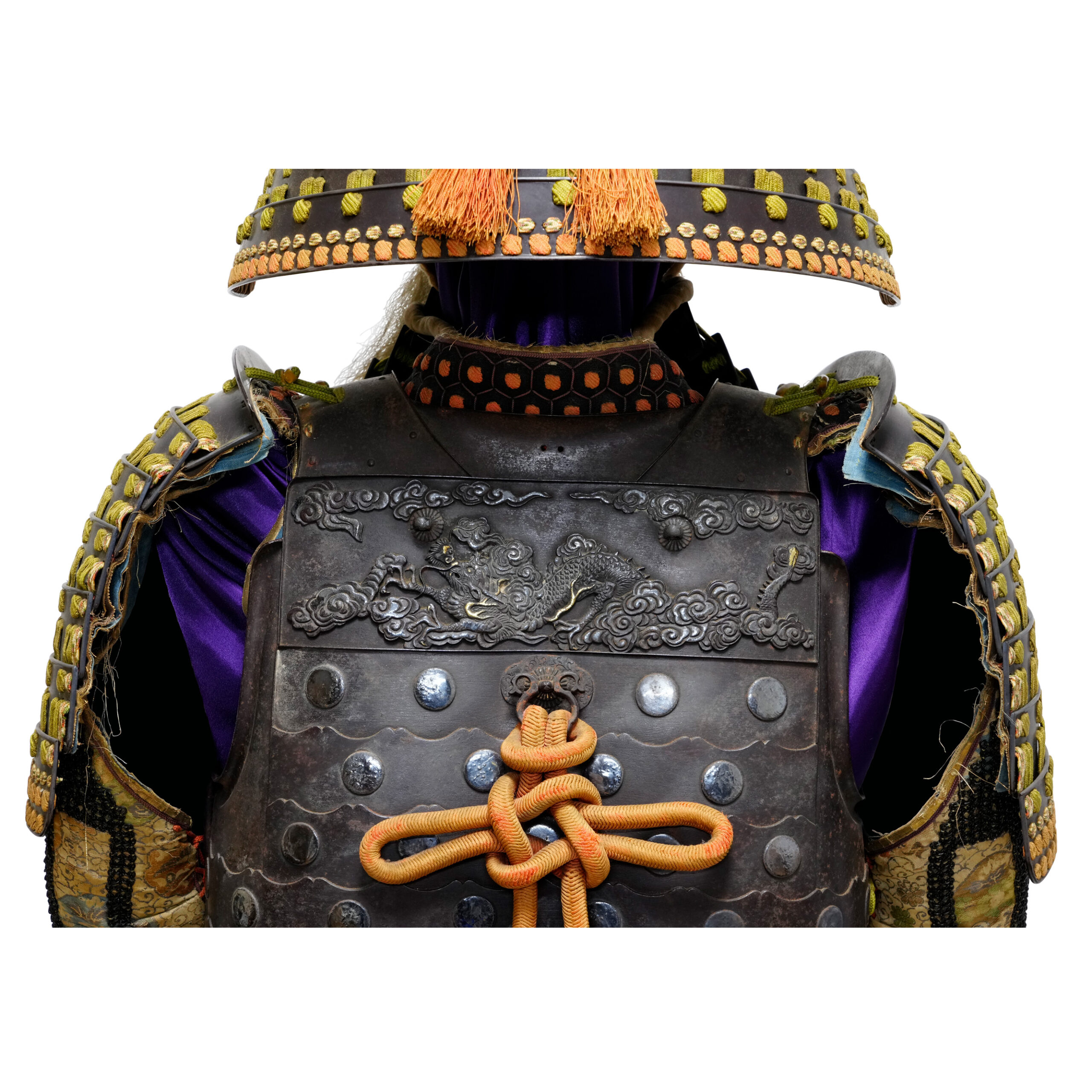
■Kusazuri (skirt of plates attached to the cuirass):
Lacquered iron Kusazuri laced with green, vermillion, and white threads. The cords for the Odoshi (縅, a technique for armor tying boards together with cords such as leather or thread) are relatively in good condition, so each plate is tied without coming off.
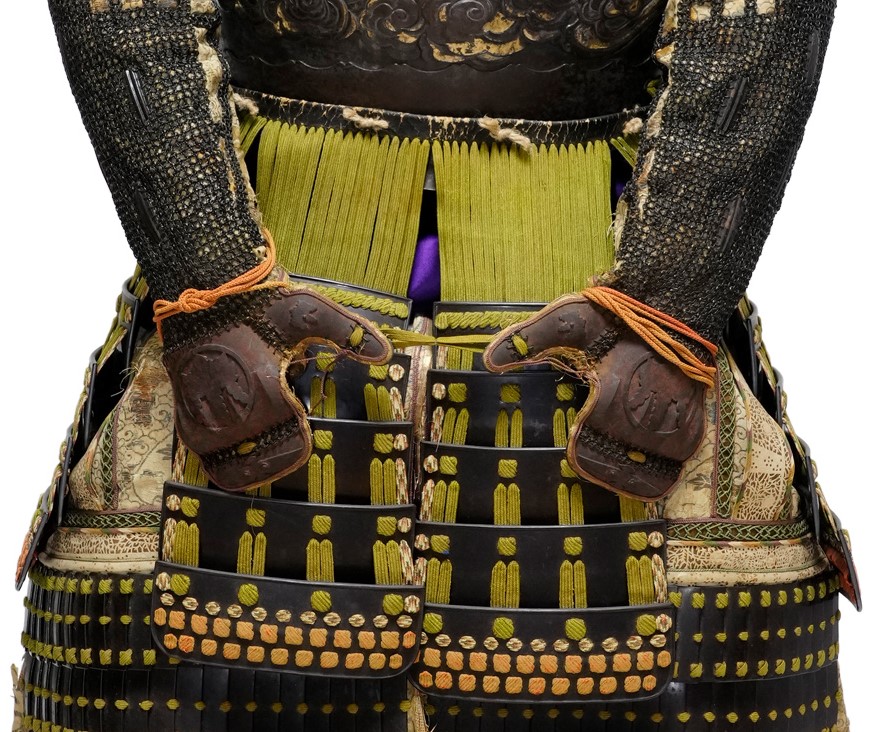
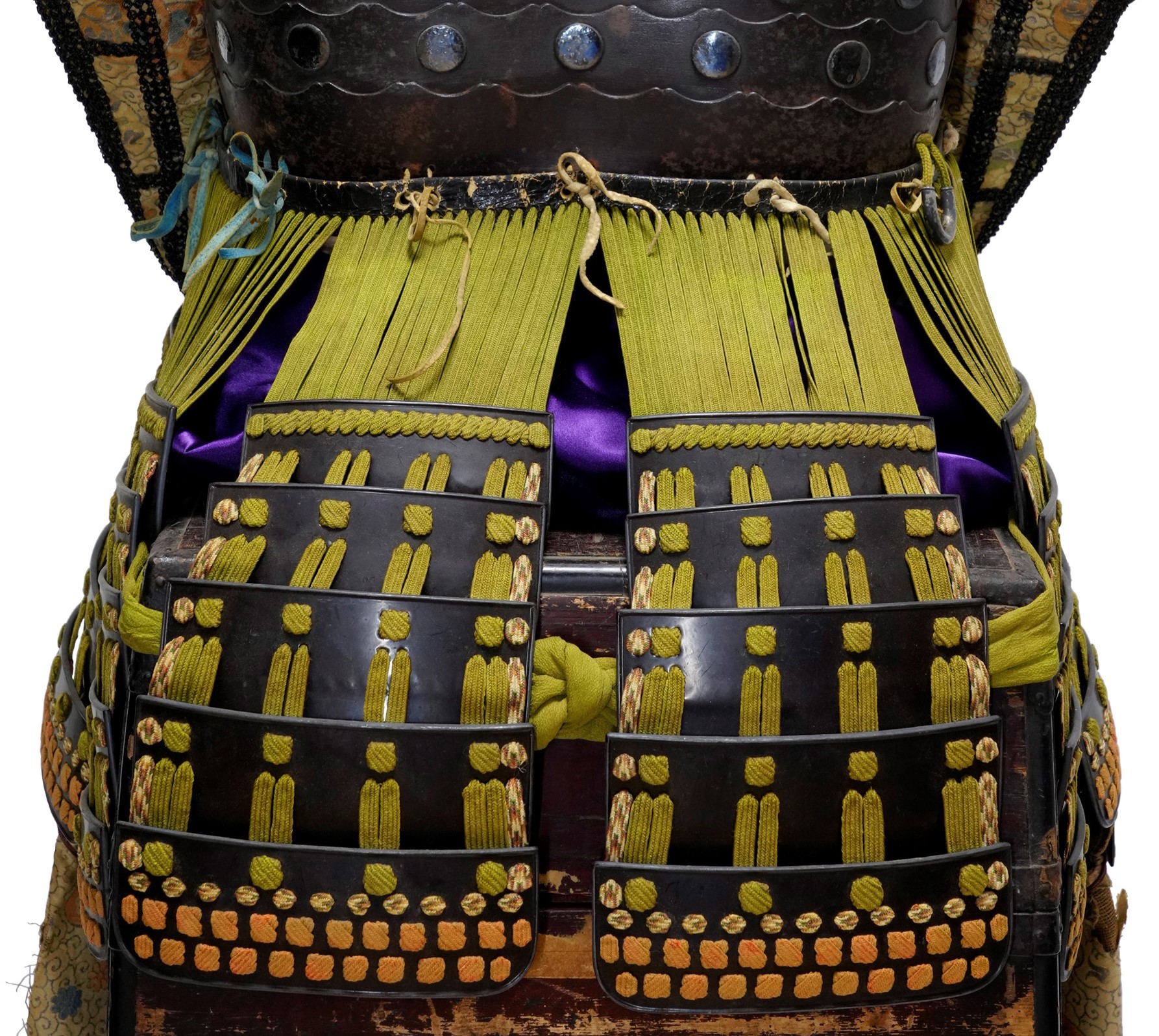
Small parts
■Kote (armored sleeves):
Intricate iron chain mail with silk.
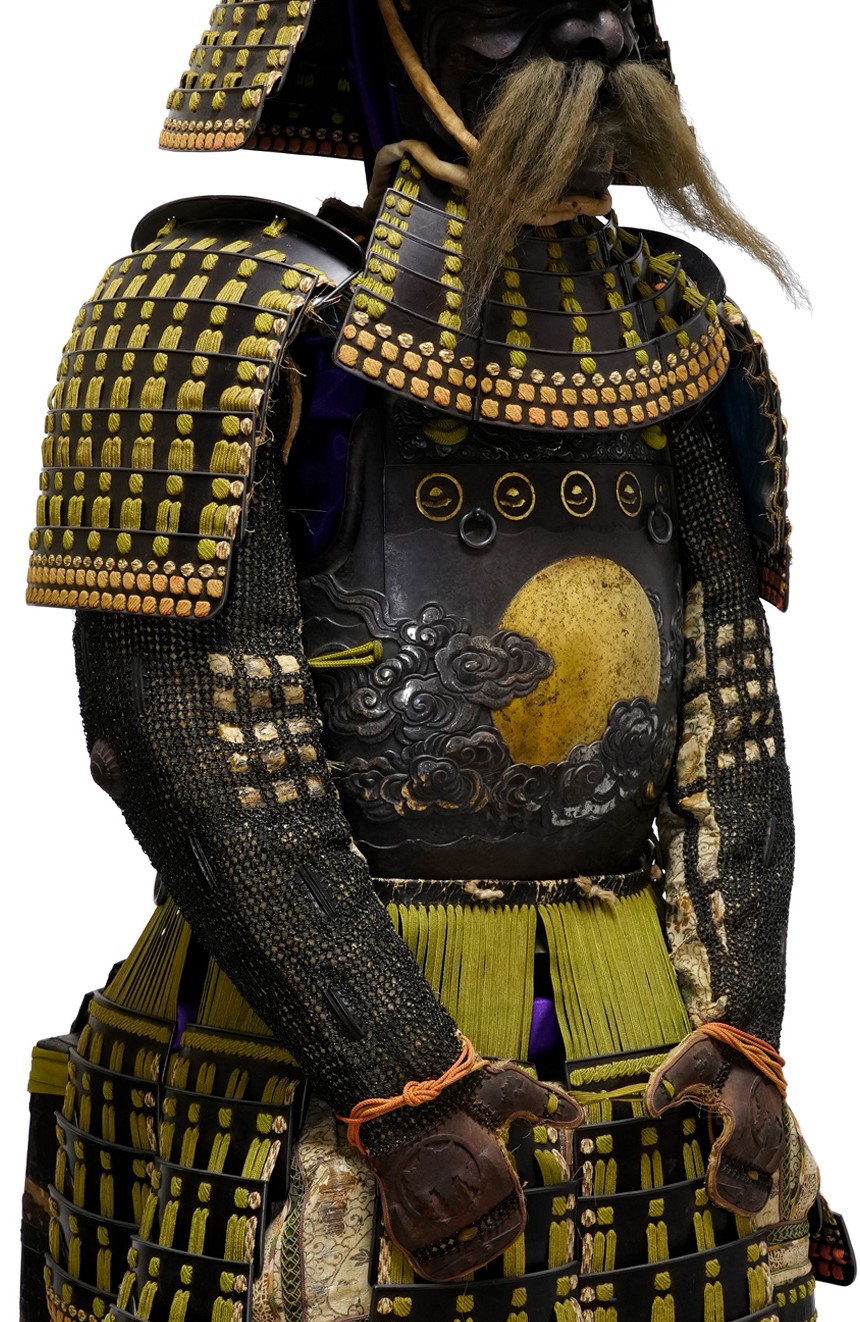
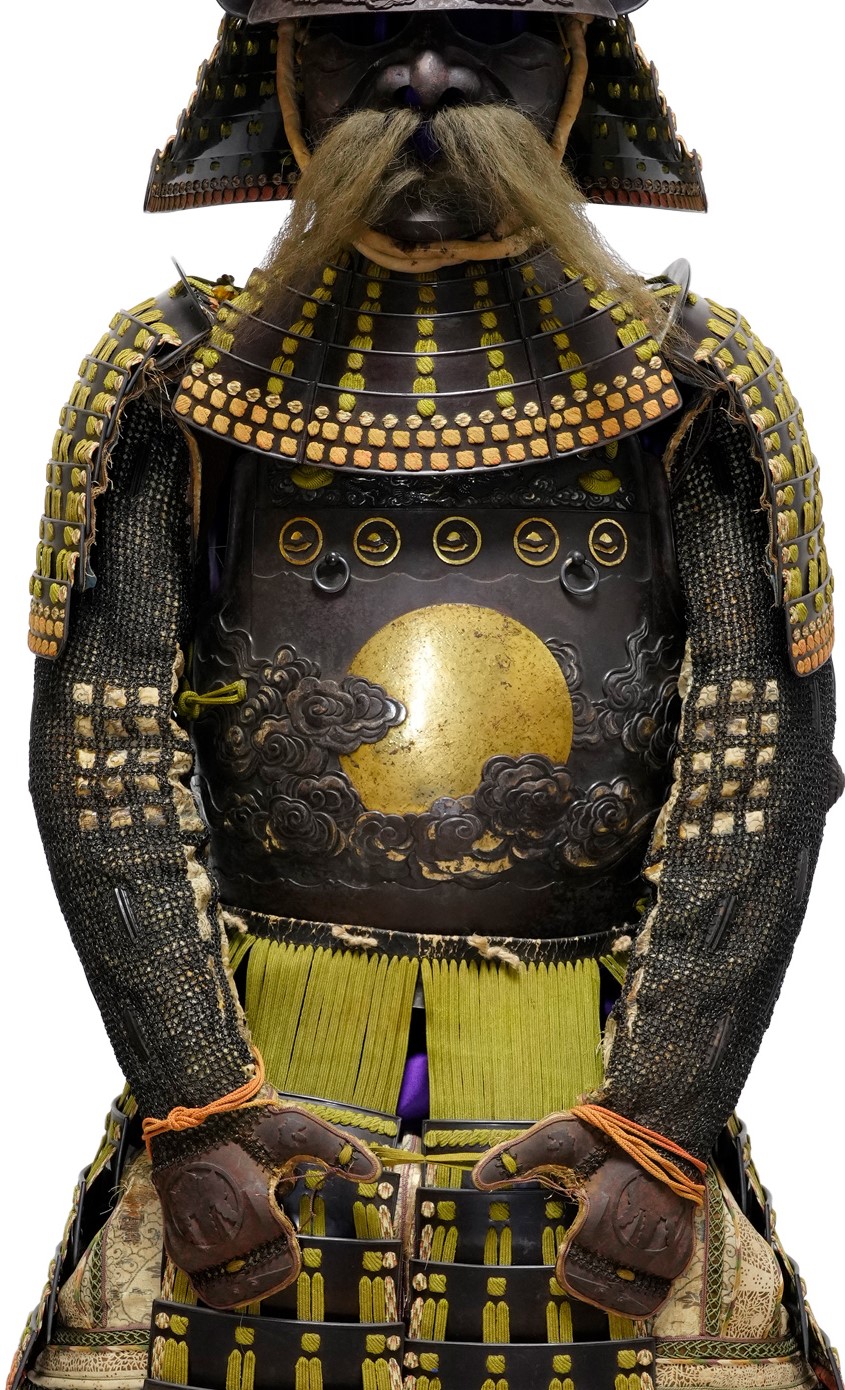
■Haidate (thigh protection):
The Haidate (佩楯) is a thigh guard. Chain mail and iron plates are attached to its cloth.
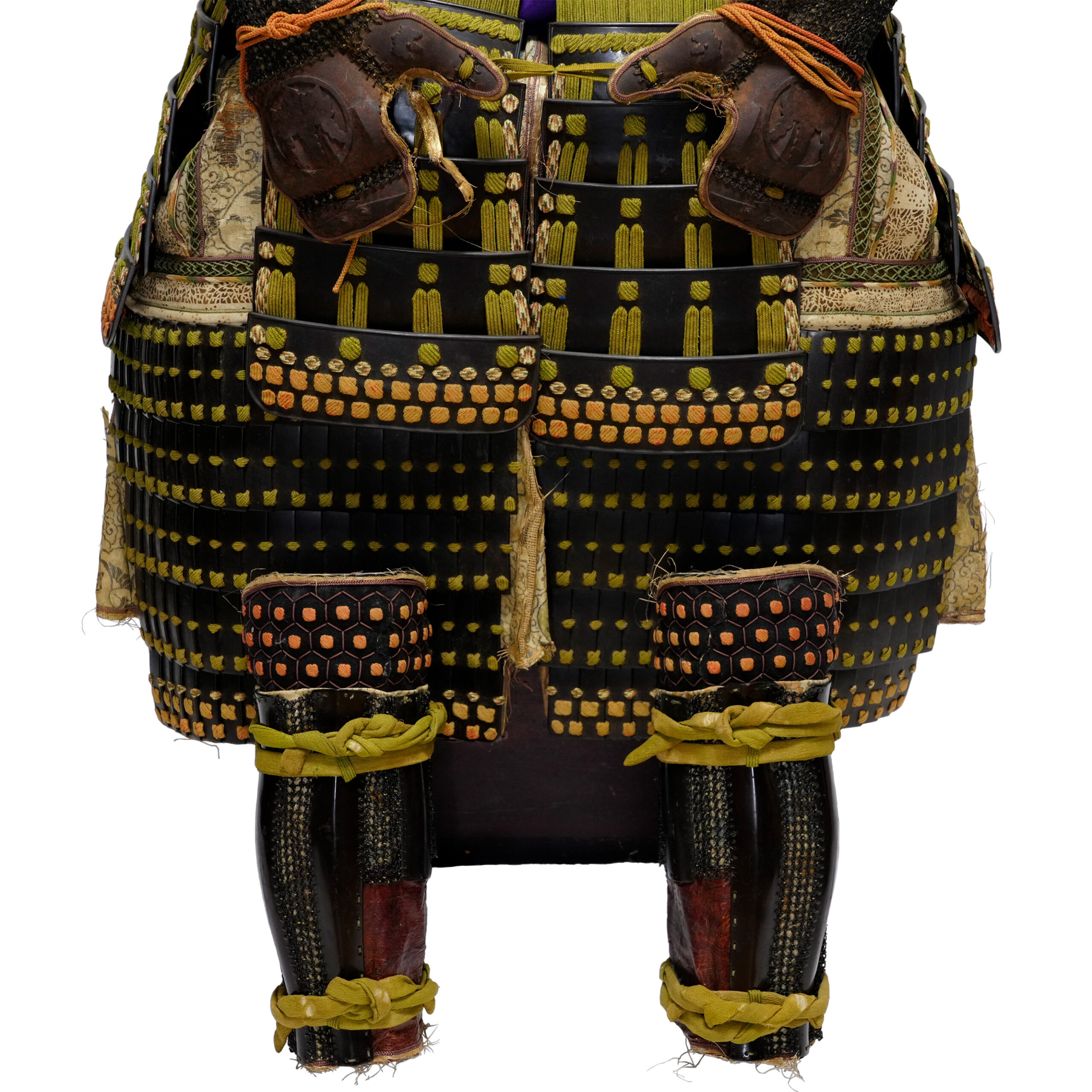
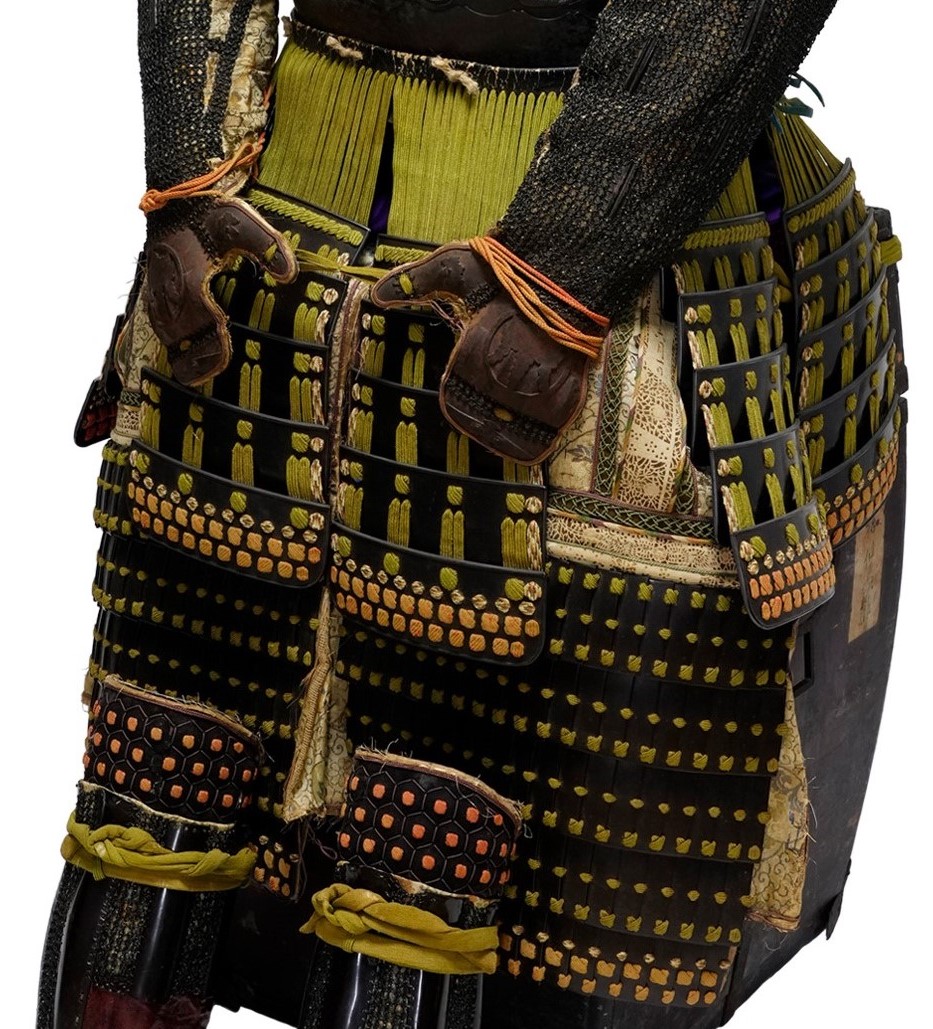
■Suneate (shin guard):
The Kikkou (亀甲, turtle’s shell) pattern is used for the cloth of the Suneate (脛当). It is a continuous geometric pattern connecting regular hexagons up and down. A theory says that this design was brought from China and the Korean Peninsula during the Asuka (飛鳥, 592-710) and Nara (奈良, 710-794) periods. A proverb says turtles live long lives; therefore, turtle and turtle shell patterns represent longevity. In addition, as this continuous hexagonal pattern does not get out of its shape, it is said people wished for eternal prosperity by using this design.
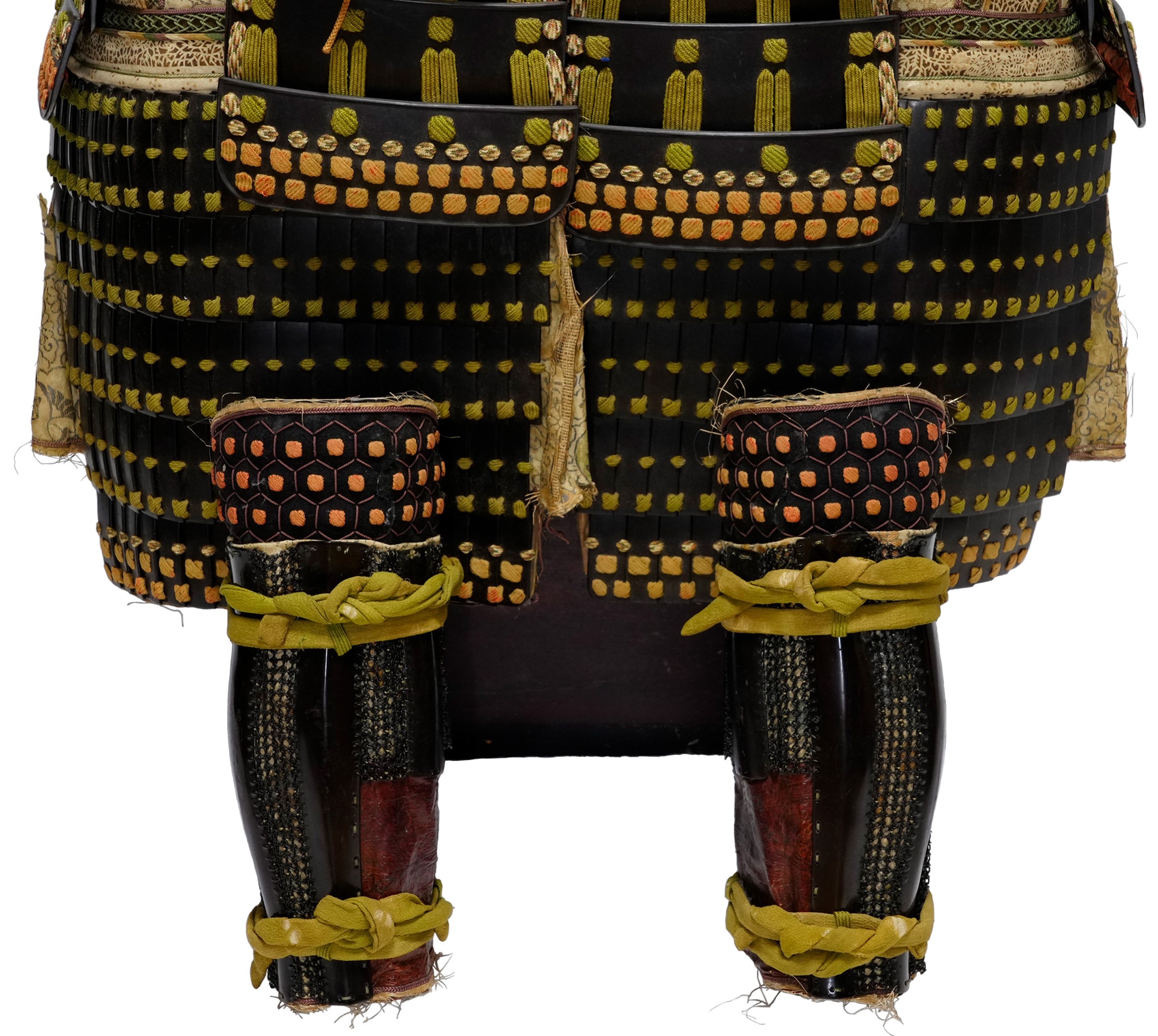
■Agemaki (decorative colorful laces with tufts):
If you focus on the back of this armor, you will find a cord tied in a dragonfly cross shape attached to the back of the Dō. This string is called the Agemaki (総角/揚巻). In order to expand the range of motion of the arm, it is said that this cord played a role in connecting and fixing the line attached to the sleeve parts. The Agemaki is a method of tying strings used in areas such as Sumo (相撲, sumō), Shinto (神道, a Japanese religion, literally means “the way of the gods”), and Ō-Yoroi (大鎧, a type of armor). And there are two types of this knot, one representing the shape of the character “入” and the other representing the shape of the character “人.” The “入” style is used when people hope to invite luck and treasure.
On the other hand, the “人” style has the meaning of protecting against evil spirits, misfortune, and danger and has been attached to armor such as the back of unprotected armor. We assume people wished that the character “入” means let people come in, and “人” means win (overcome) people. Although they are very similar, even the way they are tied has meaning and is incorporated into the decoration of this armor. The point that distinguishes these two types of knots is the shape of the upper right corner of the square knot. It could be determined by whether this shape is “入” or “人.” Here in the picture below, you would find the “人” character shape. The way of tying that matches the meaning of the knot is properly incorporated into this armor.

■Accessories: Saihai, Tabi
This armor comes with accessories that are seen in the photos below. The one is the Saihai (采配), a tool made by attaching strips of cloth or paper to the end of a stick so that it could be seen from a distance. It began to be used around the end of the Muromachi period (室町時代, 1336-1573) and is also written as 采幣, 再拝, or 采 in Japanese. This item initially comes from the Sai (旄), a tool used to call a tamed falcon, and its name influenced the name of Saihai. Those who could use a Saihai were limited to the commander of the Ashigaru (足軽, foot soldier) or above or Samurai warriors who had notable military exploits. Being allowed to possess this tool meant commanding a unit, and it was a convenient tool. At the same time, it also had a strong meaning of showing the rank and authority of a military commander. In an actual battle, the movement of the troops was controlled in detail by swinging the Saihai, such as using it as a signal to advance. The signal from this tool differs depending on each military commander, and there is no set pattern. Therefore, it was necessary for the soldiers who received the order to understand the content of the signal perfectly. A theory says that warlords chose their Saihais according to their preferences in the Warring States period. However, in the Edo period, when battles were abolished, this tool became more meaningful than ever as a symbol of authority. The Tokugawa (徳川) family, who ruled the Edo Shogunate, restricted the ownership of these tools based on social status. Saihais were generally made of paper or yak tail hair. Since the Saihai attached to this armor is made of paper, it is the one which was often used on battlefields.
Another accessory of this armor is a tool to protect the feet. From its shape, we speculate that it was probably made by attaching iron plates to the Tabi (足袋, Japanese split-toed socks) to increase its defensive properties. Due to aging, the iron plates on the right leg have peeled off from the fabric.
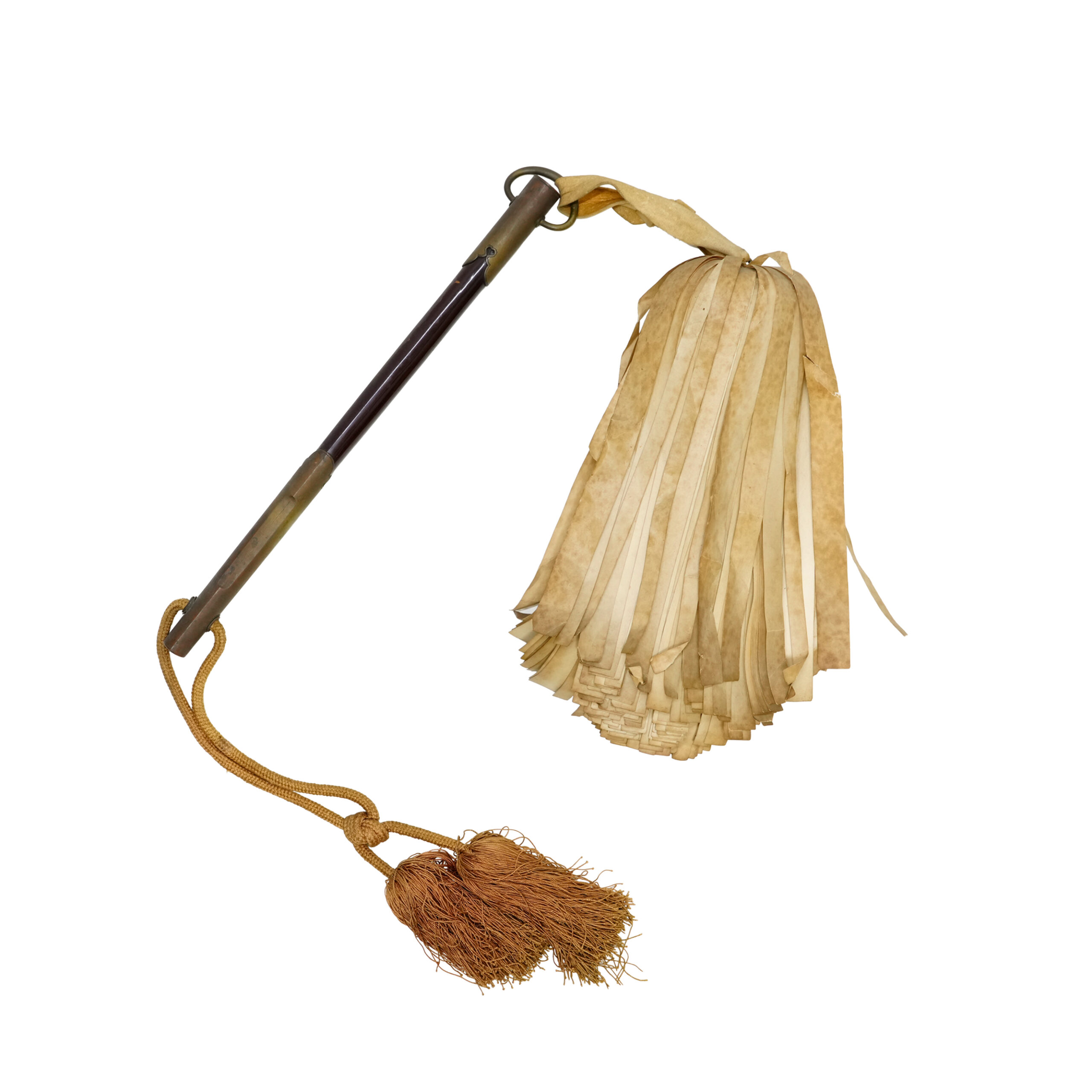

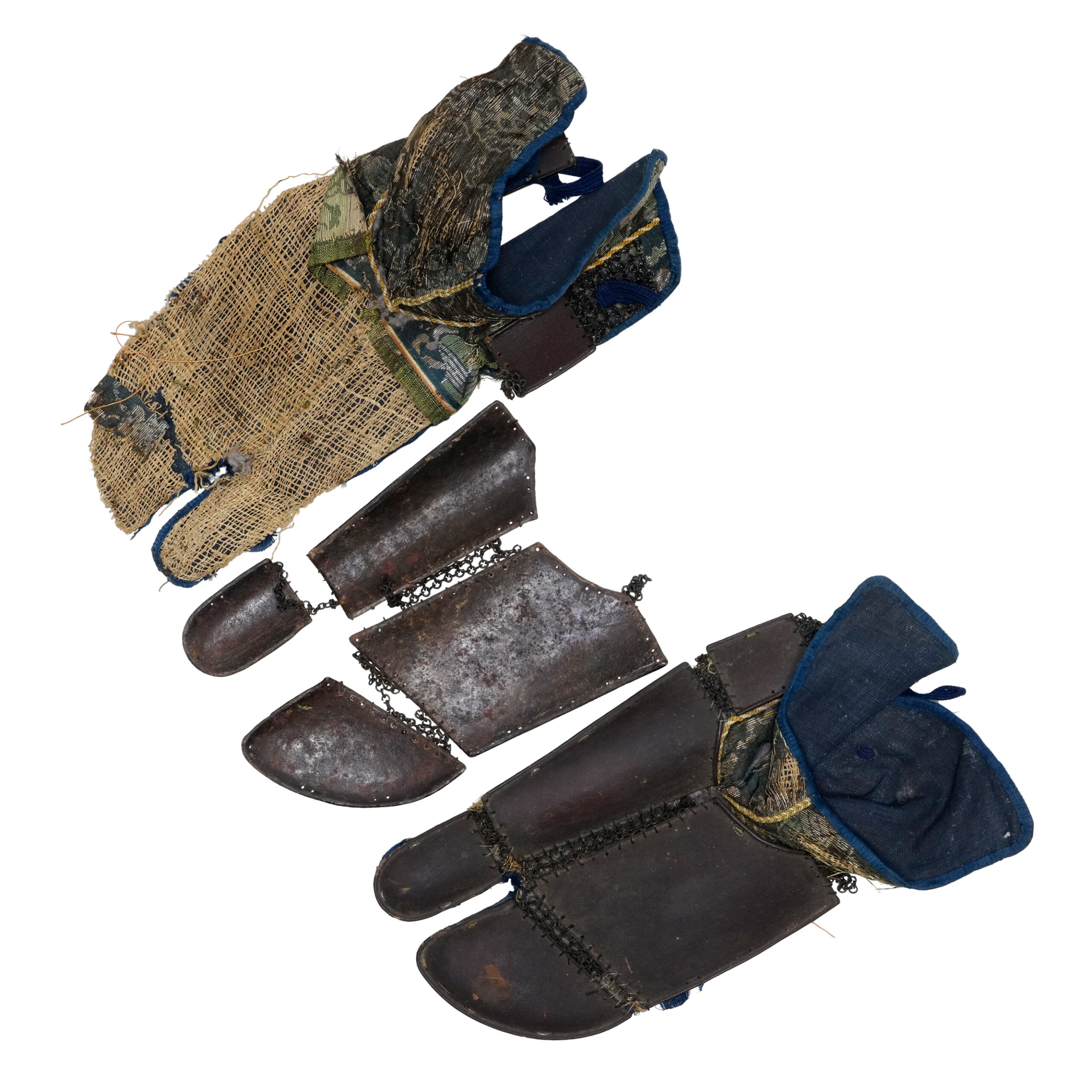
Certification: Tokubetsu Kicho Shiryo Certificate (No. 2037)
On May 14th 2023, this armor was appraised as a Tokubetsu Kicho Shiryo by The Association for the Research and Preservation of Japanese Helmets and Armor, which is the most trusted Japanese armor appraiser in Japan. This association is also known as Nihon Katchu Bugu Kenkyu Hozonkai (日本甲冑武具研究保存会). Tokubestu Kicho Shiryo (特別貴重資料) means special rare article. It is ranked as the third highest of five rankings.
The paper mentions the armor was made in the middle of the Edo period (mid 17th-mid 18th). You can receive this original authentication paper.

An English translation of the certificate is available on request. We won’t charge any additional fee.
【About us】
Samurai Museum is located in Tokyo, Japan, exhibiting antique artifacts related to the Samurai history. Samurai Museum Shop is the place for those who are interested in Japanese culture and craftsmanship. We deal with antique Samurai swords/armor, traditional crafts made in Japan and so on.
【Antique Japanese Armor and Export process】
After receiving the full payment from you, we will apply for its export permit from the agency for Cultural Affairs to legally export the antique Samurai armor to other countries. It normally takes around 2-4 weeks to receive this permit. And we would like you to expect at least 1-1.5 months for your order to arrive at your given address after you ordered.
【Payment method】
We accept payment through Stripe (Credit card), PayPal, Apple Pay or ChromePay, all of which are secure payment methods. Also, you don’t need to make an account on Stripe for the checkout. If you prefer other payment method, please contact us. You may either pay in JPY, USD, AUD, CAD, EUR, CHF or GBP. The price is set in Japanese Yen. Prices in other currencies are automatically calculated based on the latest exchange rate.

【Shipping duration】
We normally ship via EMS (Express Mail Service) provided by Japan Post. It usually takes at least 5-14 days to deliver the package after you place an order. We offer Free International Shipping as long as we can ship your order by EMS. If you prefer other shipping carriers, please contact us.
We will inform you of the order’s tracking number via email. Please make sure you fill out your valid email address correctly.
*Please keep in mind that due to the spread of COVID-19, there might be possible delays in delivery. If you like to make sure if EMS shipping is available to your country, please contact us.

【How to make sure the condition】
Please keep in mind that what you are going to purchase is an antique item. We uploaded high resolution photos for you to check its condition thoroughly. If you like to see more photos with different angles, please feel free to contact us. We will be happy to send them to you so that you can make informed decision. It is essential for us to know that you are happy with your choice of a sword. and we are prepared to use the best of our ability to serve you.
【How To Contact Us】
Please contact us through email, Facebook Messenger or Live Chat if you have any questions. You can find each icon on the right side of the website. Please click one of them to reach us. We will reply to you within 1-2 business days.
【How To Preserve Antique Samurai Armor】
Dryness, humidity, and bad ventilation might deteriorate the condition of antique Samurai armor. The best temperature to preserve Samurai armor is around 20℃ in Celsius, and humidity should be about 60%. Direct sunlight should be avoided. We recommend storing armors in a room with good ventilation. If you like to display them outside the boxes for a prolonged time, we suggest using a glass case in order for dust not to be accumulated easily. In case you don’t use a glass case, please make sure to regularly dust off from the armor by using a soft brush made of delicate cloth or brush for painting.
If you like to know more about the preservation of this armor, please feel free to contact us.

